In July of 2019, I traveled to my 73rd country, the South American nation of Suriname. Over the course of eleven days, I went deep and explored its capital city, Paramaribo, as well as several locations within its interior. There’s a lot to this country, even though it’s the smallest in South America. But I knew it’s also a country most people know very little about. So, over the course of documenting my travels around the country, my ultimate guide to traveling around Suriname was born.
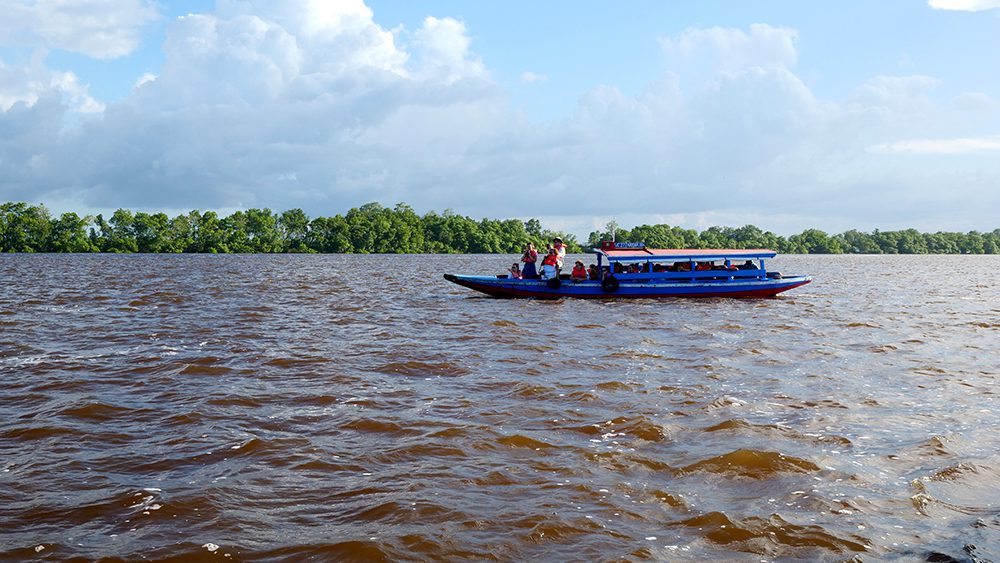
Roughly 80% of Suriname is pristine, untouched jungle, most of which is in the southern part of the country. For me, there’s nothing quite like a beautiful jungle excursion, and Suriname offers plenty of opportunities for them. In my opinion, being away from it all, in the middle of the jungle, is paradise. But just in case your idea of paradise is a modern city or sun-drenched virgin beaches, Suriname has those in spades as well.
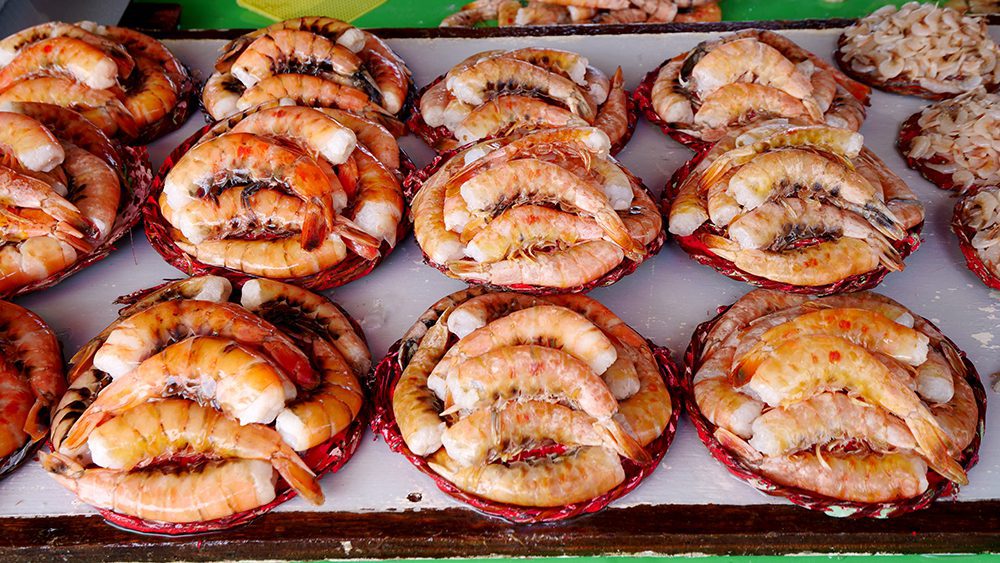
I invite you to come along with me as I detail my travels through Suriname. I’ll take you on a journey throughout this gorgeous, underrated nation, from the second I landed to the moment I left. Please feel free to use this guide as a framework for your own Surinamese itinerary. I want to inspire as many people as I can to visit this country, because as I said earlier, not enough people know it even exists. This is the ultimate guide to traveling around Suriname.
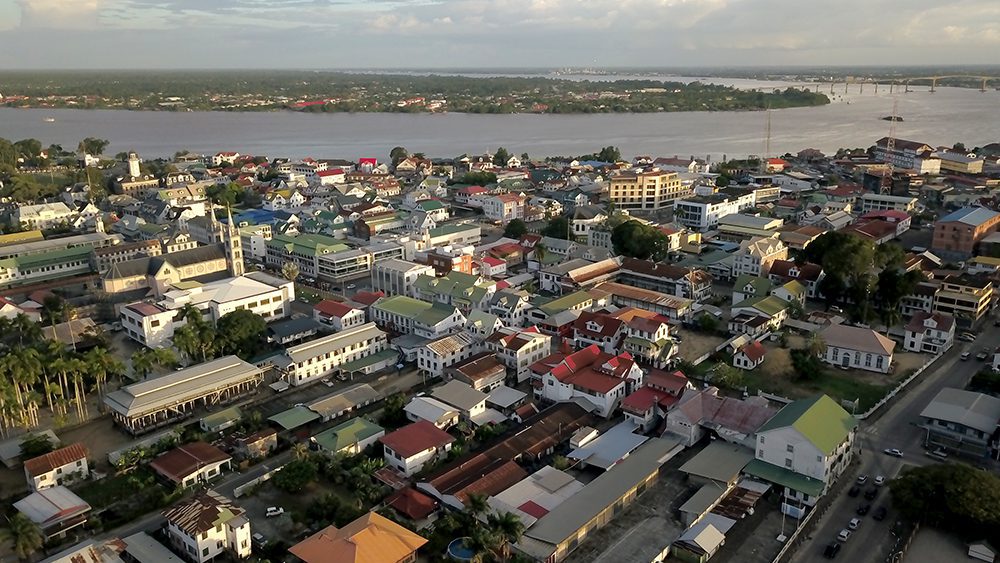
But first, a little history. I’ll be quick, I promise. Suriname has had an interesting history to say the least. Starting around 3000 BC, the area was initially inhabited by indigenous tribes like the Arawak, Carib, Akurio, Tiriyó, Warao, and Wayana. After English, French, and Dutch settlers arrived in the 16th century, the Dutch gained control of the country the following century. The Dutch then forced Africans they had enslaved and brought across the Atlantic to work on their coffee, cotton, cocoa, and sugar plantations, but many slaves escaped with the help of the tribes living deep in the country’s interior. They established their own communities and became known as the Maroons.

Meanwhile, after slavery was outlawed in Suriname in 1863, indentured servants from Indonesia and India were recruited to work on the nation’s plantations. Later in the 19th and early 20th centuries, Chinese and Middle Eastern workers were also brought to Suriname.

This history is important to know before visiting Suriname, as it explains the origins of the country’s wide and celebrated diversity. Each group that came to Suriname left their own indelible mark on the local culture and cuisine, creating a melting pot that is unlike anywhere else on Earth. The mix of people, cultures, languages, and foods—all of which seems to coexist harmoniously—makes Suriname a treasure trove for any curious and passionate traveler.

If you’re a regular visitor to my blog or YouTube channel, you’ll probably know that I’m all about independent travel. I like to plan my trip myself and then contact locals in the destinations I’m traveling to who can show me around. I’m not usually into tour companies unless their guides are true, knowledgeable locals who can show you the hidden gems that don’t make it onto top 10 lists and travel guides. Thankfully, I found two tour companies in Suriname that met my every need.
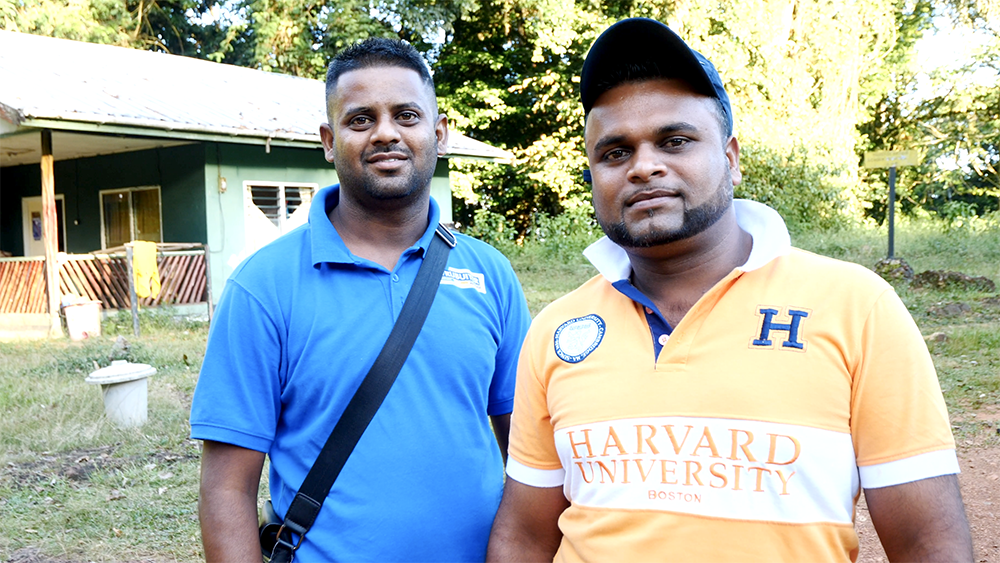
In this guide to traveling around Suriname, I highly recommend Jenny Tours, who took me around the country for the majority of my trip and allowed me to have the Suriname experience I wanted. They offer a whopping 76 tours on their website, so there’s plenty to choose from. For the majority of my adventures with Jenny Tours, my guide was a friendly man named Imro, who helped make my time in Suriname super smooth and enjoyable. Near the tail end of my trip, I traveled with other knowledgeable guides named Jan and Roël. Both of them made my last few days in Suriname very enjoyable!

Toward the tail end of my trip, I traveled to Palumeu, which is located deep in the rainforest in the southern part of the country. There, I spent a couple of days with Julius, my guide from Mets Tours. If you’re planning on exploring the jungles, rivers, and villages of the Palumeu area, there’s no one better than them!

Now that we know the history of Suriname and who to hire, let’s discuss how to get there. The best way to get to Suriname is to fly Surinam Airways. They are the flag carrier of the country, so nearly all travel to the country goes through them.

As of November of 2019, they operate out of 10 destinations around the world, including the Netherlands (where the bulk of the country’s tourists come from). Surinam Airways also operates out of Guyana, Brazil, French Guiana, Barbados, Aruba, Curaçao, Trinidad and Tobago, Orlando, and my hometown of Miami, Florida.

If you’re from the United States, I recommend flying to Miami International Airport and then catching a connecting Surinam Airways flight from there to Aruba. The flight to Aruba takes a little over three hours and you’ll likely have a short connection there. From there, it takes another 2 ½ to three hours to get to the capital of Suriname, Paramaribo.
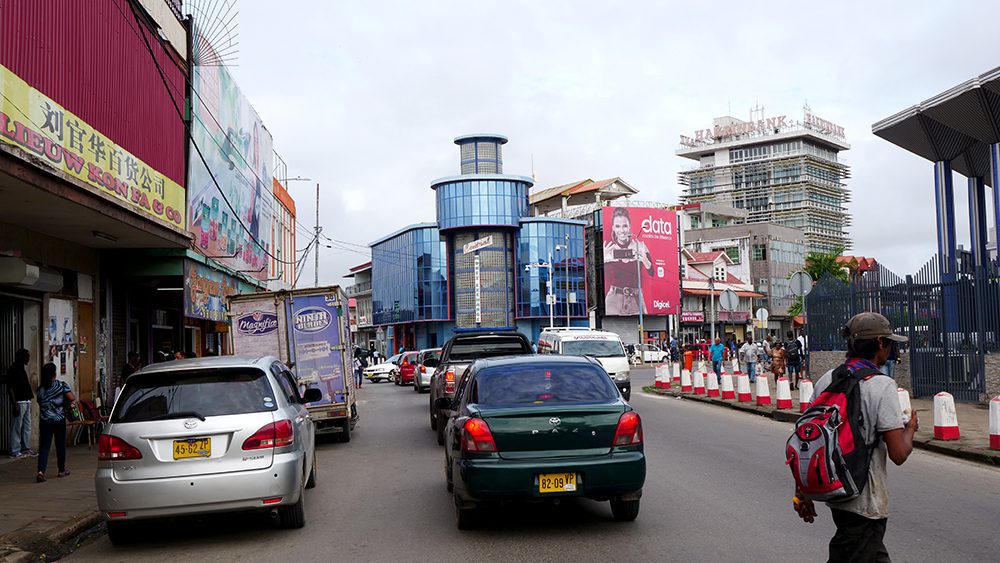
The distinctive blend of cultures that make Suriname so unique is on full display in Paramaribo, which serves as a gateway to exploring the country. But before you head out to experience other Surinamese destinations, take at least a couple of days to explore the capital.

The city is an interesting mix of historical Dutch architecture with African, Chinese, and Asian influences at every turn, in an unmistakable Caribbean-esque setting. You can experience this unique mix at its Sunday markets, including the aptly named Chinese Market, where you can find pork and chicken buns and shumai.

If you’re in the mood for Indonesian fare, Saoenah Markt is a wonderful spot to try liver satay, lumpia, and fried banana. In this guide to traveling around Suriname, I will probably mention peanut sauce quite a few times. Basically, if you have the option of having a dish with peanut sauce, always get the peanut sauce! It’s the best!

Also, don’t forget the Central Market! There, you can get a glimpse of local life while trying Surinamese favorites like smoked catfish and a coconutty slush pom de citerre. For unique souvenir shopping, check out the Amerindian Craft Market near the river.
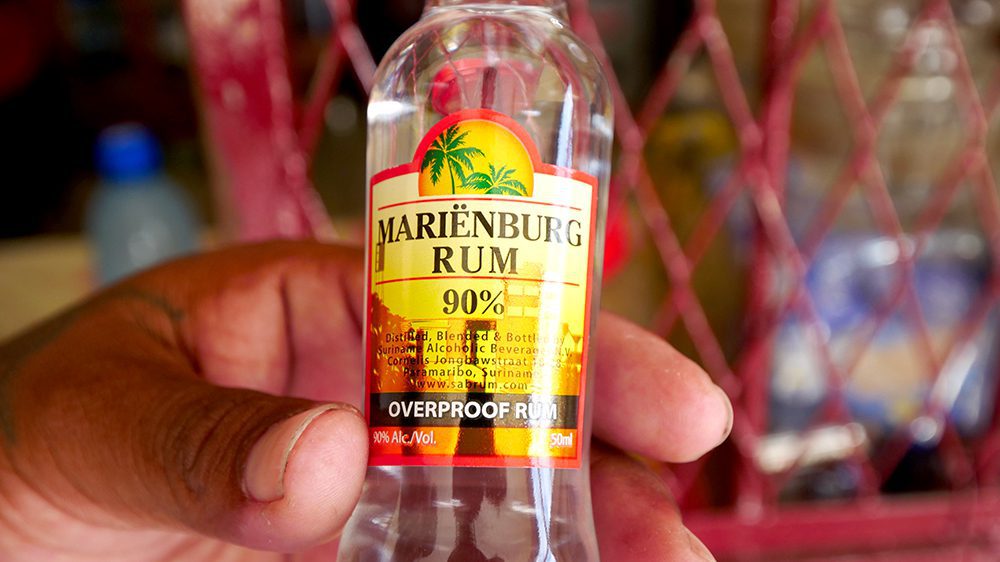
To try some of Suriname’s strongest liquor, get the Mariënburg rum at Lai Ghoon Bar. If you’re a beer drinker, head over to Suriname Supermarket and try the different varieties of Atlas Beer!
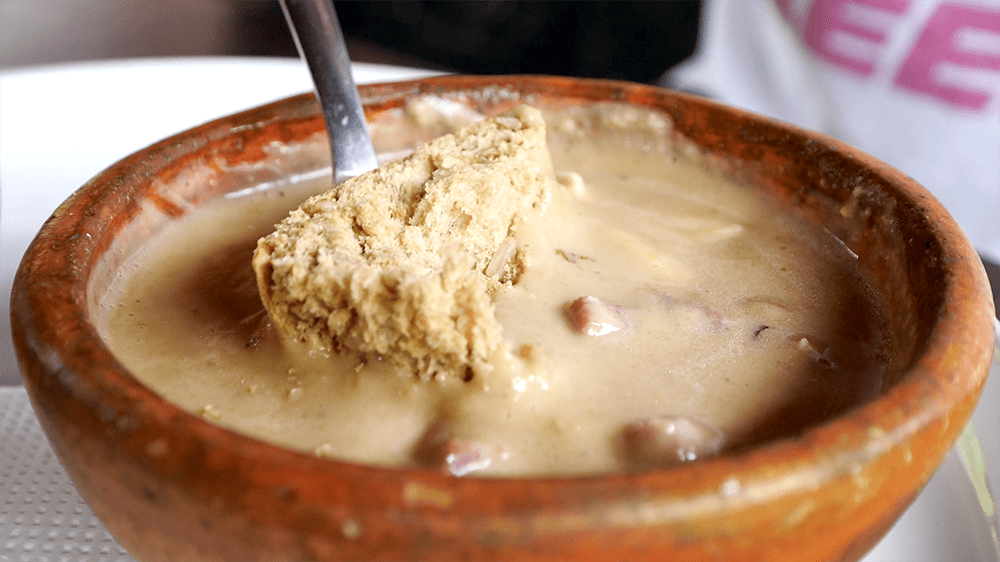
To have a nice change of pace from street food, be sure to check out Paramaribo’s amazing restaurant scene. Whether you have a Dutch- and Indian-inspired breakfast at Cafetaria de Smaak, enjoy the peanutty Crunchy Pinda soup at Souposo, or indulge in a Javanese buffet at Jakarta Restaurant for dinner, it’s hard to go wrong here!
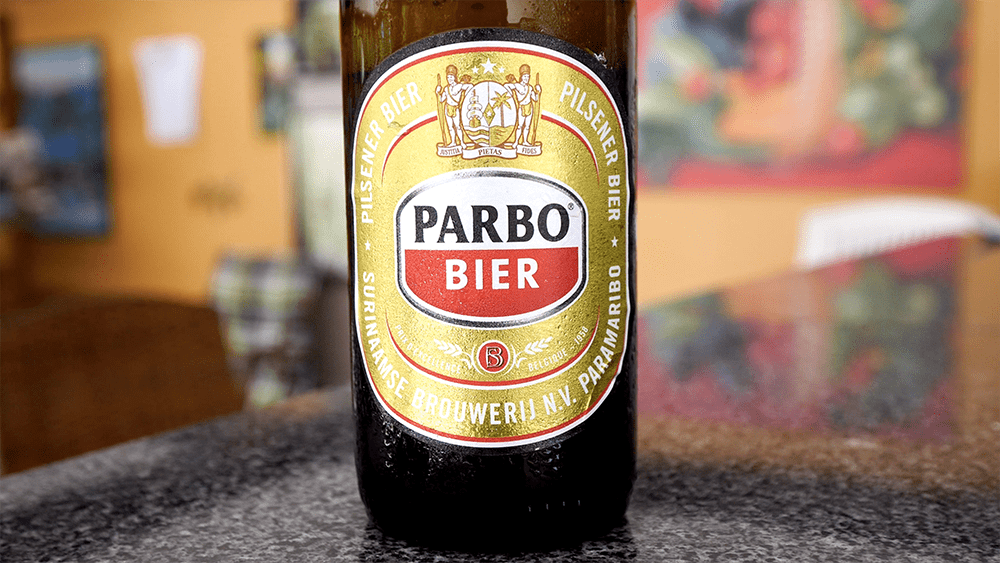
And if you’d like to dance the night away or just kick back with a nice beer at the end of a long day, seek out a Brazilian block party! I dare anyone to sit still as festive Latin rhythms ripple through the night air!
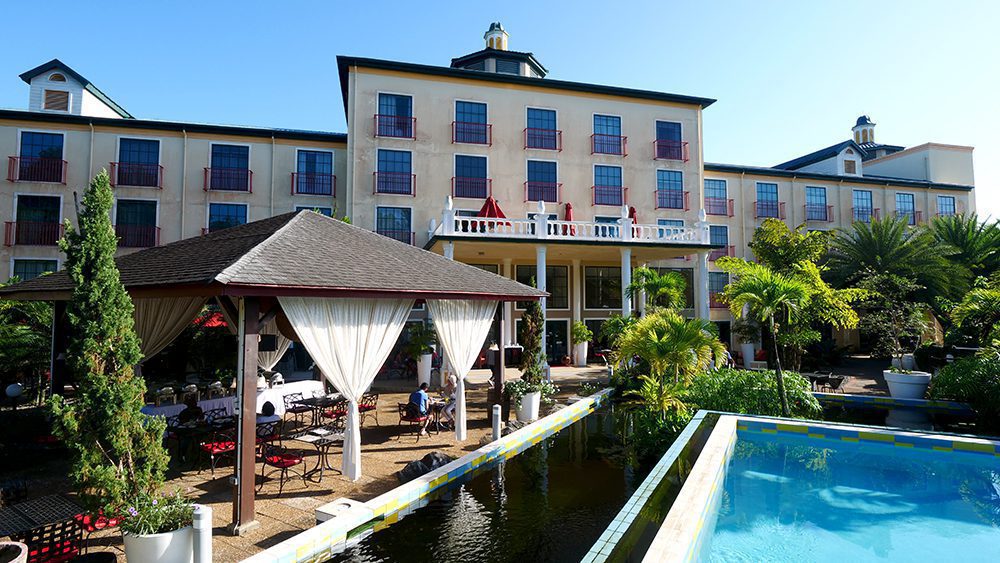
As far as lodgings are concerned, Paramaribo has a nice mix of options for every budget. If you have the money for a luxurious, $100+ USD per night stay, check out the modern and magnificent Royal Torarica Hotel. On the low end is the Guesthouse Kiwi, which offers very basic and standard accommodations for $20 USD per night. This guide to traveling around Suriname recommends picking whichever one fits your style and budget.

In the middle is the Downtown Oasis, a comfortable luxury guesthouse and condominium complex in the heart of downtown. They offer both rooms and apartments. A room there will cost you around $44 USD per night, while apartments range between $55 and just over $82 depending on the size and number of bedrooms.
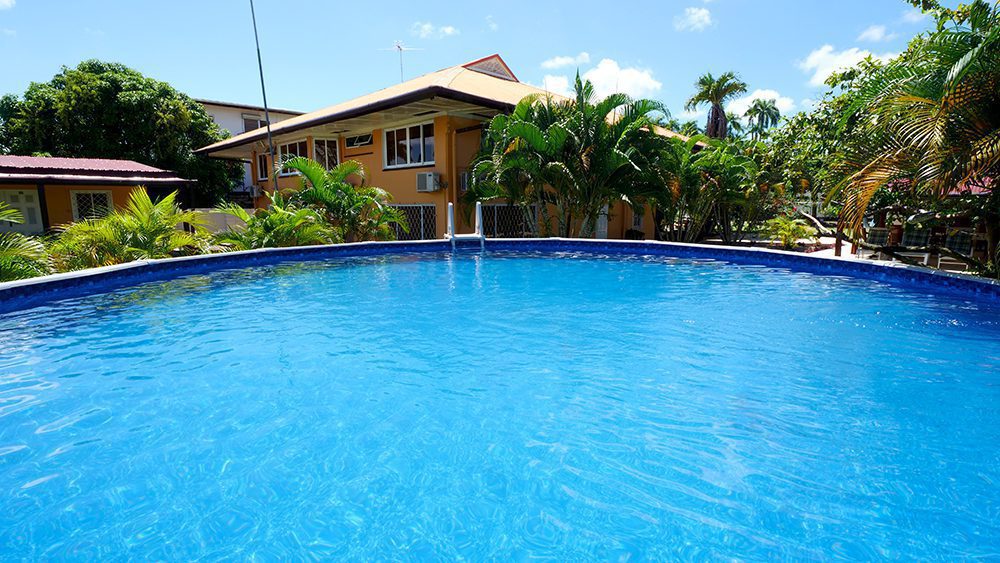
I tried out all three options as I criss-crossed the country, but I chose the Downtown Oasis for the bulk of my time in Paramaribo.
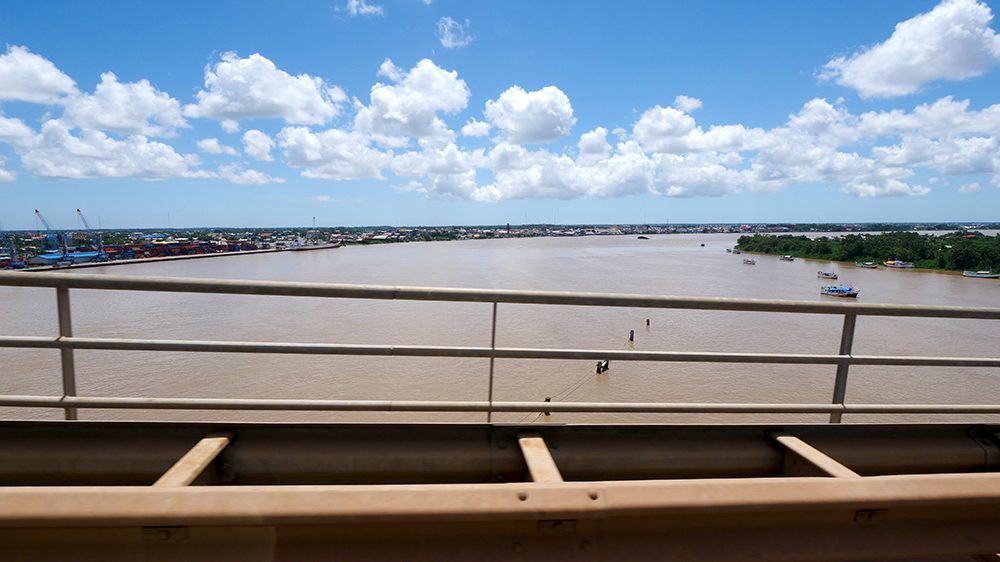
After spending a couple of days in Paramaribo, a great choice for your next destination is the oceanside town of Galibi. This town of roughly 750 people is best known as a prime location for seeing nesting sea turtles. However, it takes a fair bit of road-tripping to get there.

To get to Galibi, you’ll have to make the trip in three phases. The first phase will see you follow the East-West Verbinding east through the town of Tamanredjo. This town is 95% Javanese and is a great place to stop and have some delicious Indonesian food. This guide to traveling around Suriname recommends Warung Lenny. Get the fried chicken, noodles, rice, fried banana, sprouts, and beans with the peanut sauce!

Continue east along the East-West Verbinding as it becomes the Julianaweg Weyneweg until you reach the port town of Albina along the Maroni River. During the roughly 4-hour journey from Paramaribo, you’ll pass roadside stands selling everything from fresh coconut to 90-proof alcohol to fresh acai puree! Once you reach Albina, you’ll need to visit the riverside gas station in town to buy gasoline for the boat ride up to Galibi. Right across the river are the jungles of French Guiana but save that for another adventure!
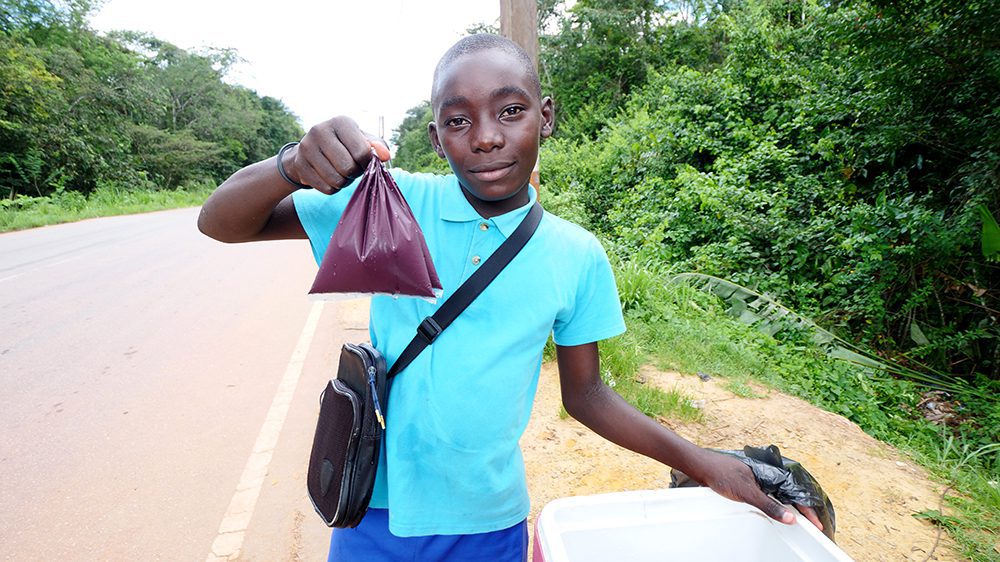
After you’ve purchased the gas (and maybe a beer for your boat captain), you’re ready to set off from the port. After a 100-minute ride in a small, motorized canoe up the Maroni River, you’ll be greeted by the pristine, virgin beaches of Galibi.
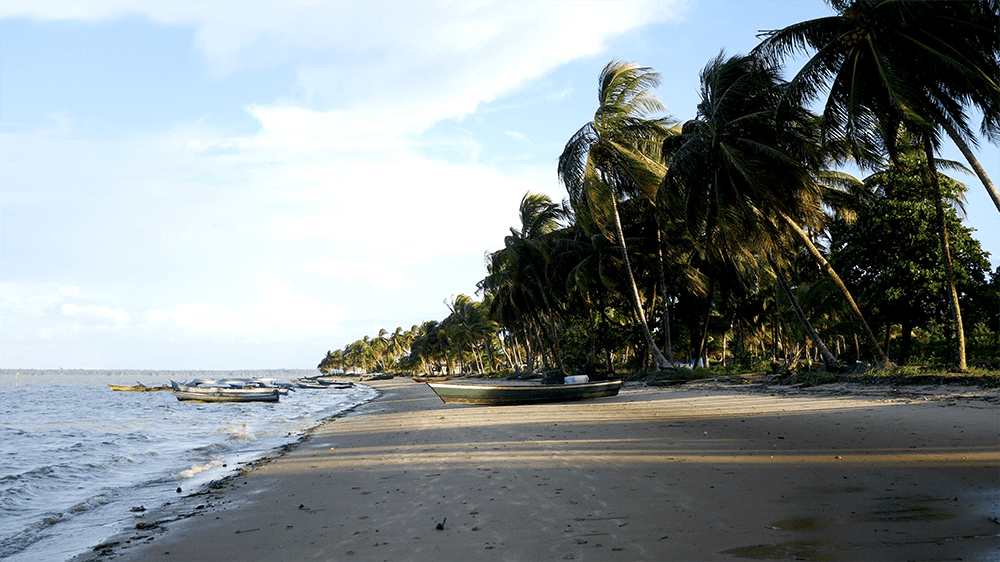
The town of Galibi is the northeastern-most settlement in Suriname. It lies along the Atlantic Ocean at the mouth of the Maroni River. Because of its proximity to two major bodies of water, Galibi has access to some of the freshest seafood in Suriname!

The locals here are incredibly friendly, so don’t be surprised if you get invited to join them for a meal. Whether you try the local specialty, smoked catfish, or another mouthwatering dish like wild boar or curry crab with casaba bread, you can’t really go wrong here. Well…maybe you can. The crab brains—another specialty here—are definitely an acquired taste. I usually love brains, but these were a little too extreme for me!

The main reason people visit Galibi is to observe the sea turtles that nest there during the late winter and early spring. The baby turtles, which include green sea turtles, the Olive Ridley turtle, and the massive leatherback turtles, can be seen hatching as late as June. Unfortunately, I visited in July, so the window to see any of these majestic sea creatures had passed. But even if you visit outside of nesting season, you can always learn about the turtles (and see life-sized sculptures of them) at a hut on the northern side of town.

Galibi may be quiet and quaint, but this guide to traveling around Suriname will show that there are other interesting things to do there. I recommend strolling the beaches, where you’ll find trees with fresh mangoes and casaba melons growing on them. The mangoes are quite citrusy and have a nice tang to them! Don’t forget to explore the small downtown area, where you’ll find a church, a banquet hall, a soccer field, a handful of homes, and the Sint Antonius primary school. The kids there are nice but shy!
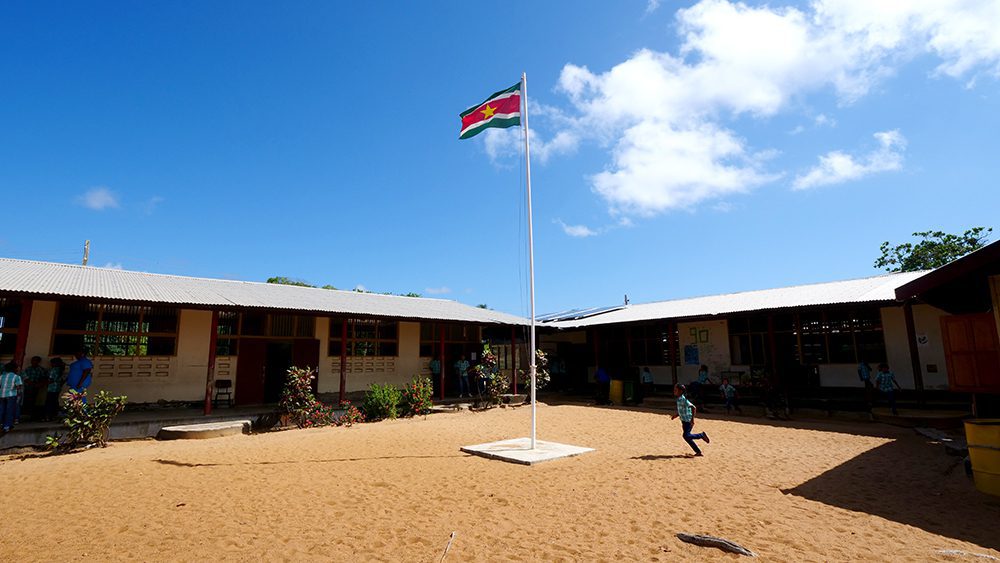
During your time in Galibi, this guide to traveling around Suriname recommends staying at the Myrysji Lodge. There, you’ll enjoy basic but comfortable accommodations with twin beds, mosquito netting, and a view of the river. They also offer fantastic fare at their open-air dining hall, including Dutch crepes with salty and spicy minced fish for breakfast. In the evenings, try the buttery snapper in a creamy and spicy broth or the snapper in tomato sauce. Or, if you’re like me, get both!

If you’re not visiting Galibi during sea turtle nesting season, you can probably see everything the village has to offer in 24 hours. Regardless of how long you stay, though, your Suriname adventures shouldn’t end there. I personally suggest heading to the Ston Eiland area just outside of Brownsweg next.

To leave Galibi, you’ll go back the way you came: back up the Maroni River to the riverside town of Albina. If you’re anything like me, the 100-minute ride up the jungle-lined river will leave you with a hankering for some Surinamese cuisine. To quench it, stop by the Freedom Café, a small takeout spot with a few seats where you can eat inside. Go with the pork tail, chicken, smoked fish, rice, chilies, peas, and vegetables. It’s quite the meal and is rich in heat and flavors that range from Chinese-influenced to African-inspired!
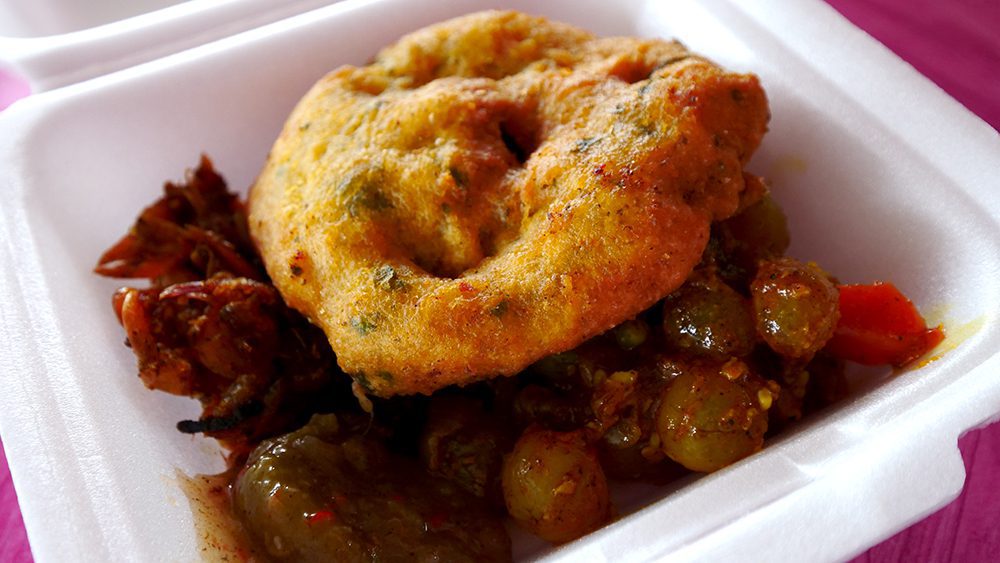
From Albina, follow the Julianaweg Weyneweg and the East-West Verbinding toward Paramaribo. On your way to Paramaribo, be on the lookout for a small roti shop just outside the city that sells Indian food. You must try their vada with catfish roe chutney, which is nothing short of spectacular! This guide to traveling around Suriname also recommends the spicy shrimp chutney!
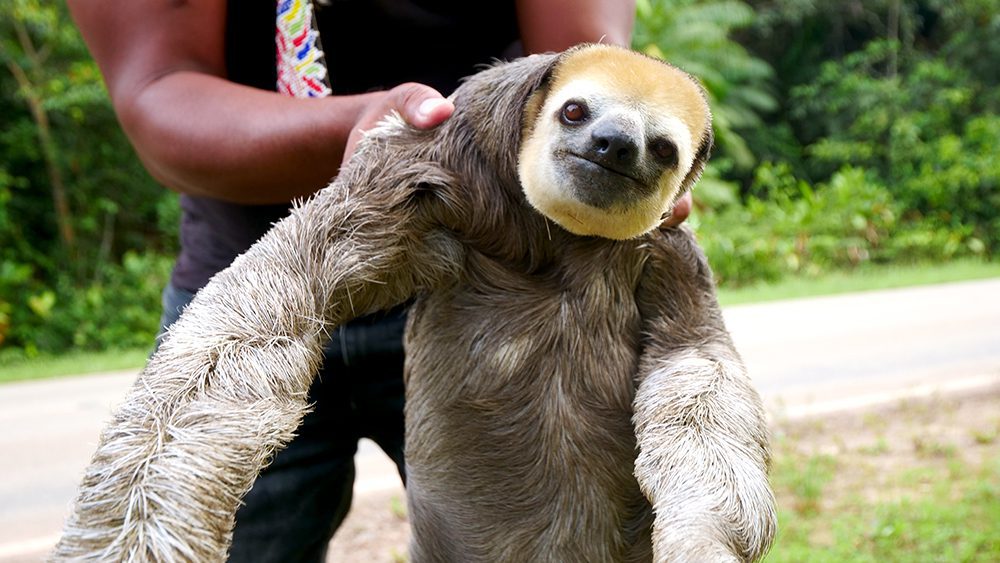
From there, follow the Martin Luther Kingweg road south until you reach the village of Berg en Dal. There, take a southwest turn and follow it until you reach Brownsweg.

Follow the main road south from Brownsweg and continue south. After roughly 10 minutes, you should reach the Ston Eiland peninsula on the banks of the Brokopondo Reservoir. Of course, if you book with Jenny Tours like I did, you don’t have to worry about directions and should be able to just enjoy the ride.
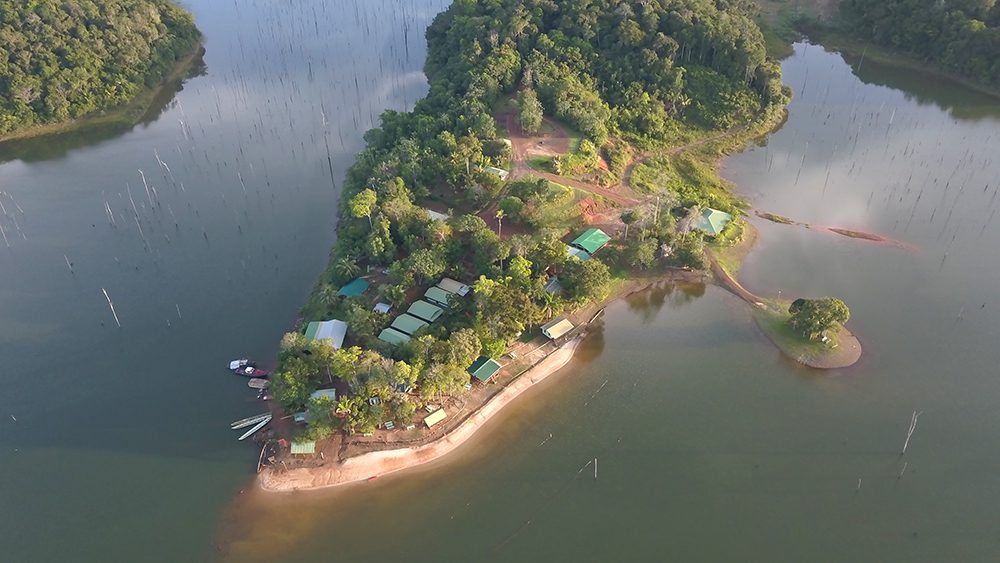
Ston Eiland (pronounced like “Stone Island”) is pretty far off the beaten path, even for Suriname’s standards. But the peninsula’s relative isolation, surrounded by rainforest along the man-made Brokopondo Reservoir also makes it a gorgeous hidden gem. It’s the perfect spot to enjoy the beauty of the lake and surrounding jungle, but is still close enough to Brownsweg that you can take a quick trip there for anything you need.
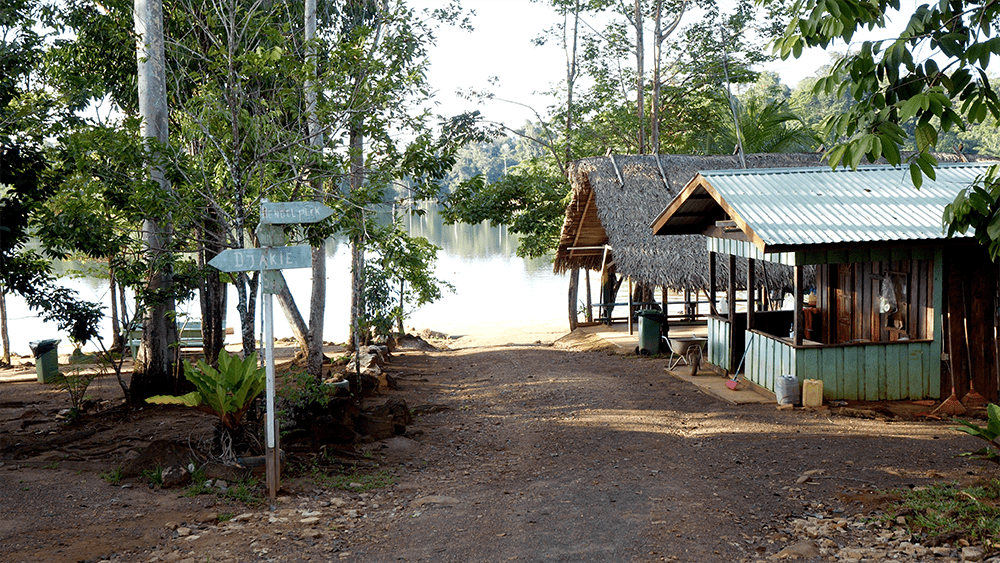
During your stay at Ston Eiland, this guide to traveling around Suriname recommends the Stone Island Lodge. This lodge is more of a campground and is located right along the shores of the reservoir. Again, the accommodations are basic while still providing everything a traveler could need. The sleeping quarters and bathrooms are nice and clean, and the kitchens are a decent spot to cook. Note that Jenny Tours will provide a chef for you if you book with them. But best of all, the lodge has much-needed air conditioning, as daytime temperatures often skyrocket into the triple digits.
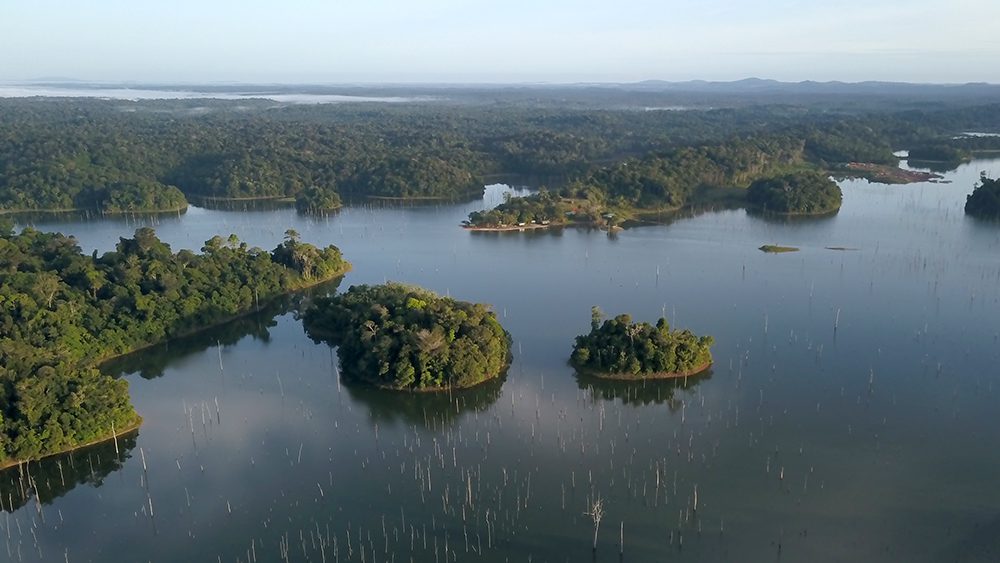
As a lakeside resort, the Brokopondo Reservoir will likely be at the center of the activities you enjoy at Ston Eiland. The reservoir was formed back in the 1960s after the Suriname River was dammed, filling a forested valley. The long-dead tops of the trees still poke out of the water to this day, creating a sight that’s both beautiful and eerie.
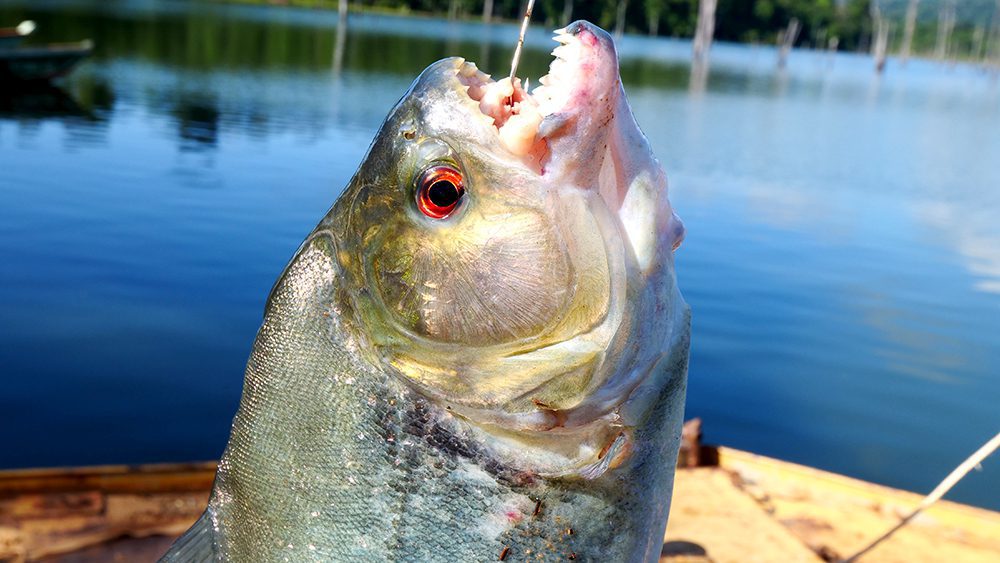
You can fish for piranha in the reservoir. They seem to have an affinity for raw chicken. These notorious fish are actually quite tasty when fried up, if a little bony. I suggest going for the cheek meat and spreading the ribs, as it’s much less likely to find stray spines and bones there. Be careful while eating the piranha regardless. A stray bone nearly got lodged in my throat and almost made me throw up!
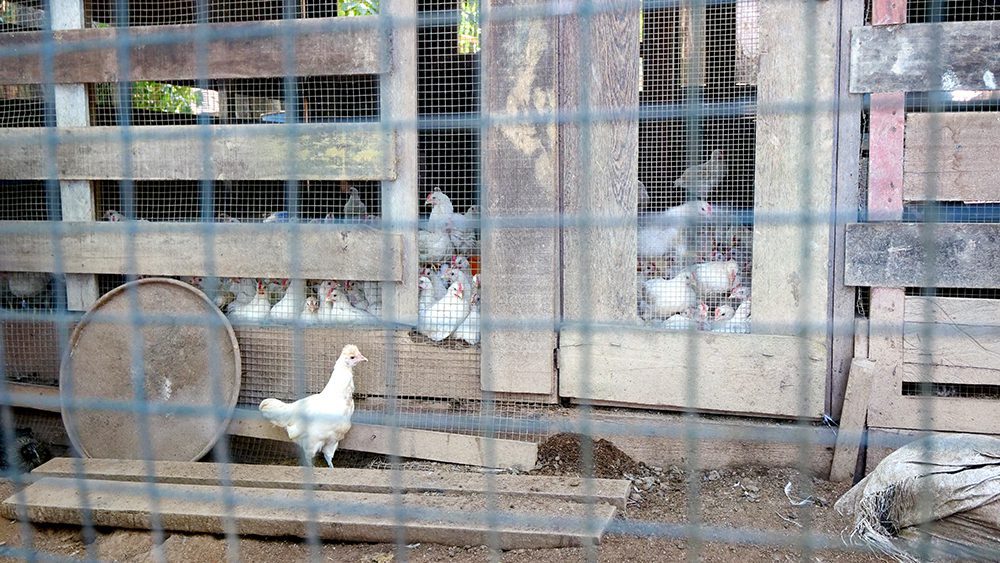
Another fantastic activity in the Ston Eiland area is trekking through the jungle surrounding the reservoir. You can also take a boat ride across the reservoir and visit Howler Monkey Island. The island got its name from the colony of howler monkeys that occupy its canopy.
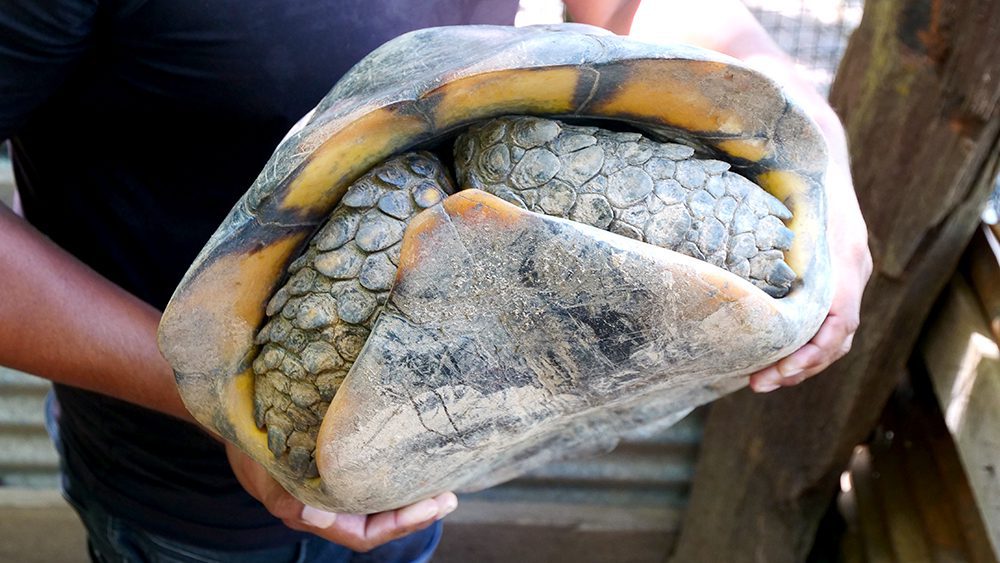
Be aware that these monkeys, while often loud and vocal, can also hide very well, so you may not get a good look at them during your visit. Something you should be able to see is the huge yellow-foot tortoise who lives on a small poultry farm on the island. He’s an absolute monster of a tortoise but is actually a gentle giant.
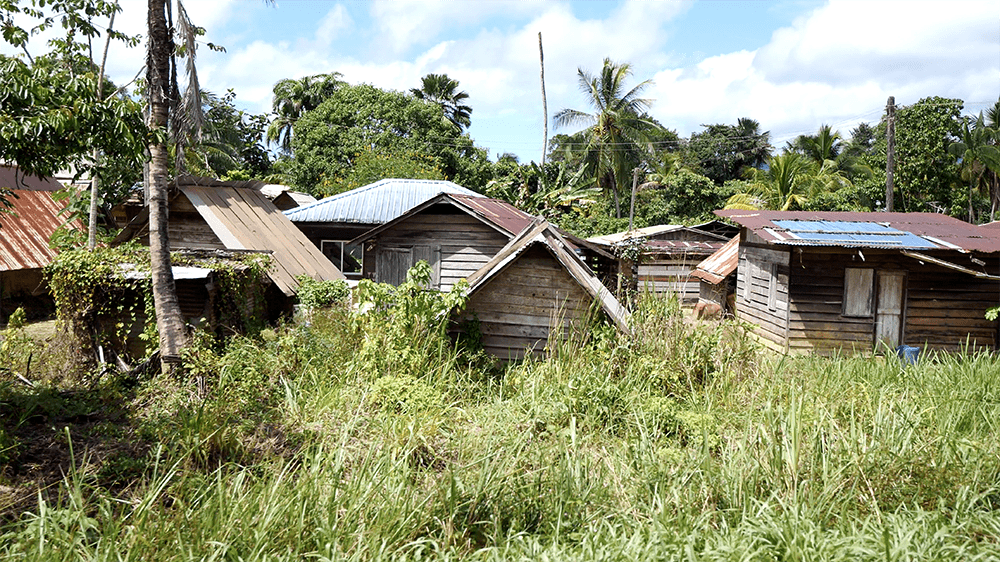
Of course, with a town so close to Ston Eiland, you’ll likely want to do some exploring there as well. Some might think Brownsweg is too small to be of interest to most travelers, but I beg to differ. This town of roughly 4,800 residents is a great spot to get a feel for what it’s like to live in Suriname’s interior.
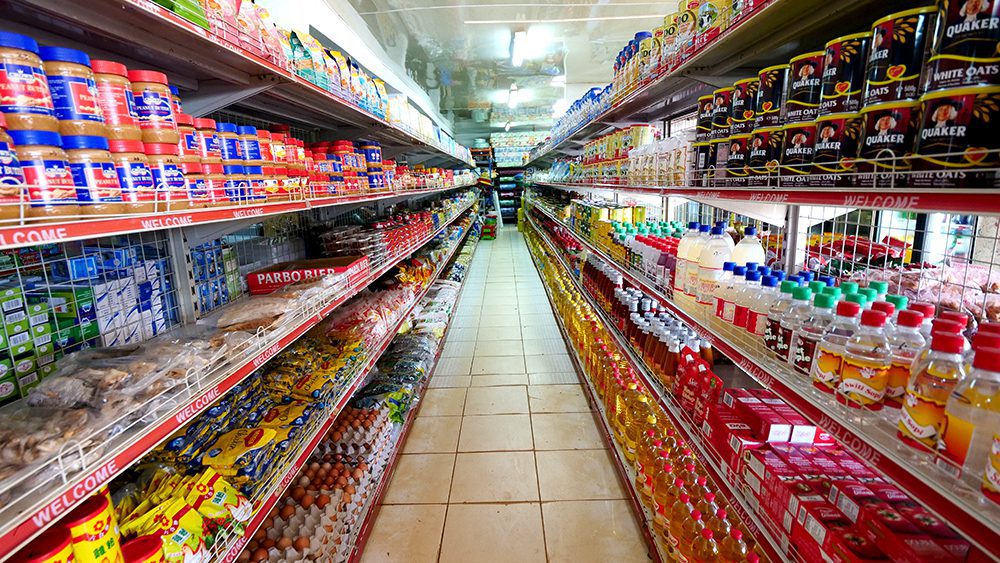
Brownsweg is a mostly Maroon settlement, made up of the descendants of slaves who escaped into the jungles of Suriname centuries ago. Located just a 10-minute drive from Ston Eiland, it’s a great place to stock up on food and supplies.
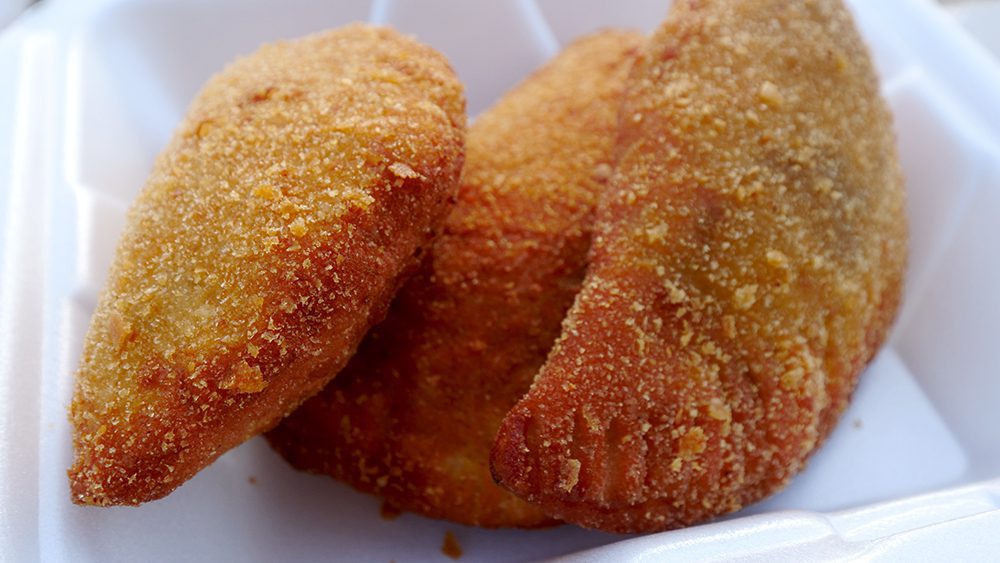
There is a Chinese supermarket there that sells chicken, fish, bread, Nutella, coconut drinks, and other foods. You can also buy Chinese-inspired chicken empanadas! I also recommend the shrimp empanada, which is thinner and crispier than the others but packed with mouthwatering flavor. If you plan on fishing in the Brokopondo Reservoir, the supermarket is also a great spot to buy fishing hooks.
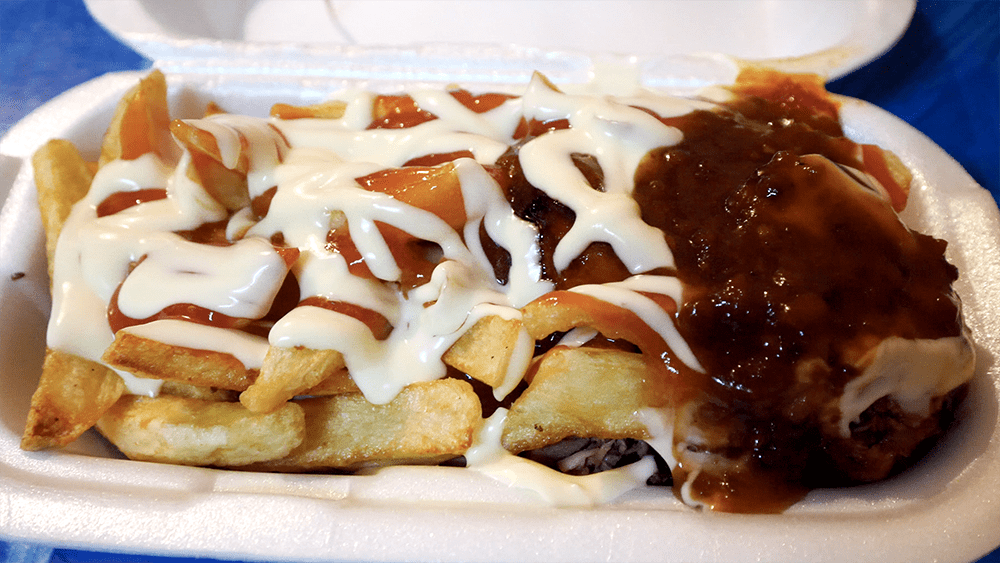
At night, you can return to Brownsweg for dinner. I had an amazing meal in a tiny hole-in-the-wall there that consisted of Indonesian-inspired chicken with peanut sauce and fries topped with mayo and ketchup. Like every chicken you’ll find in Suriname, this chicken is super fresh, moist, and tender.
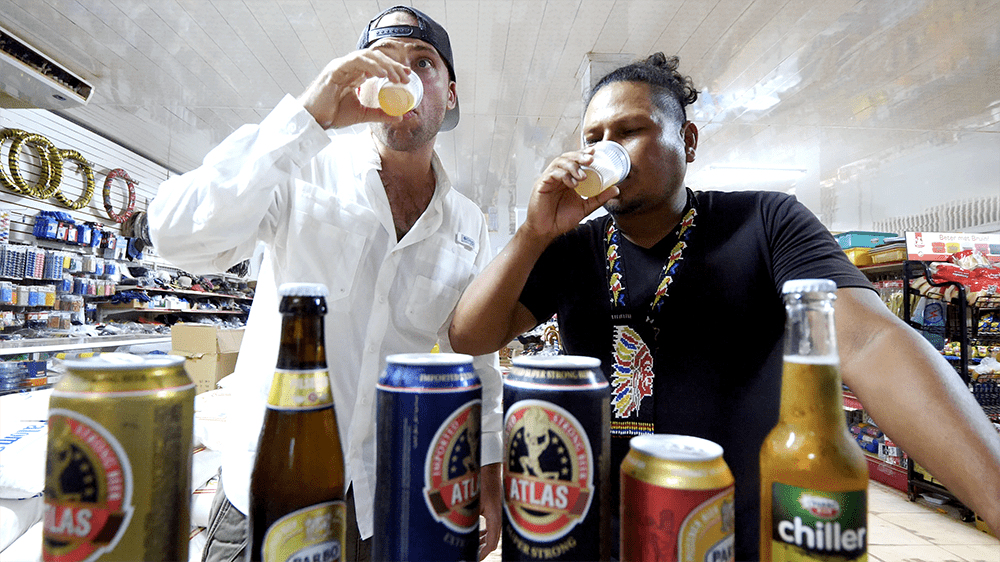
After you eat, head over to the supermarket to get some Atlas beer. I suggest trying them all but beware: the one that’s 14% alcohol was way too strong even for me! While you’re there, this guide to traveling around Suriname also recommends buying about 1.5 meters of cloth. The locals use it to protect their head and neck from the sun, while women also use them as skirts.
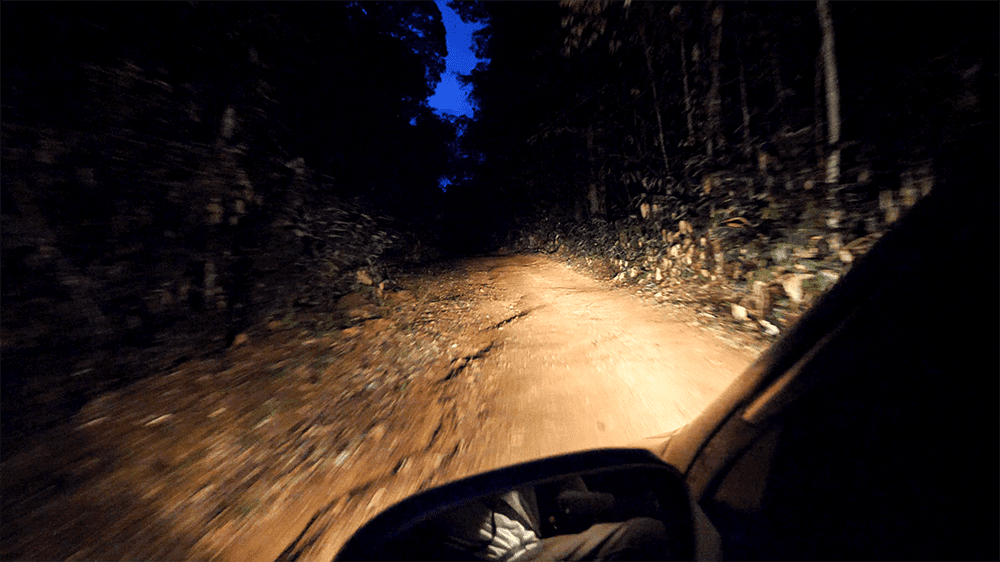
After you’ve enjoyed Brownsweg and Ston Eiland, it’s time to head to your next destination! Don’t worry—we’ll be back in the general area of Brownsweg soon. But for now, let’s make our way to our next stop. I recommend heading deeper into the interior of the country with a stay on Isadou Island.
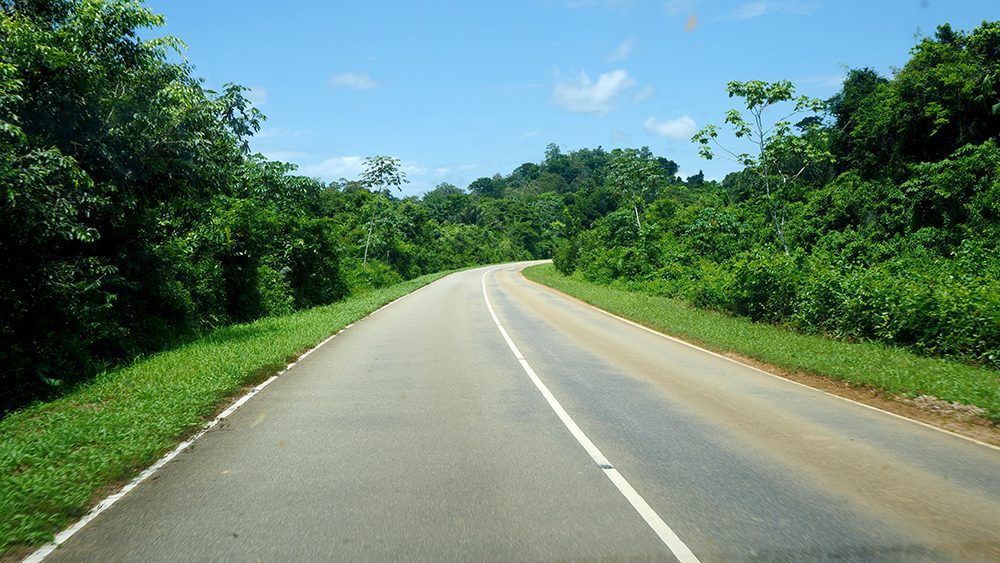
From Brownsweg, follow the main road heading west from town. Follow it as it turns to the south and southwest for about 75 minutes toward the town of Pokigron. Along the way, you’ll pass by some of Suriname’s gold mines and lots of jungle brush. As you head south toward Pokigron, stay on the lookout for wildlife. They occasionally cross the road and you don’t want to accidentally hit them. Once you make it to Pokigron, continue on to the port of Atjoni along the Suriname River.
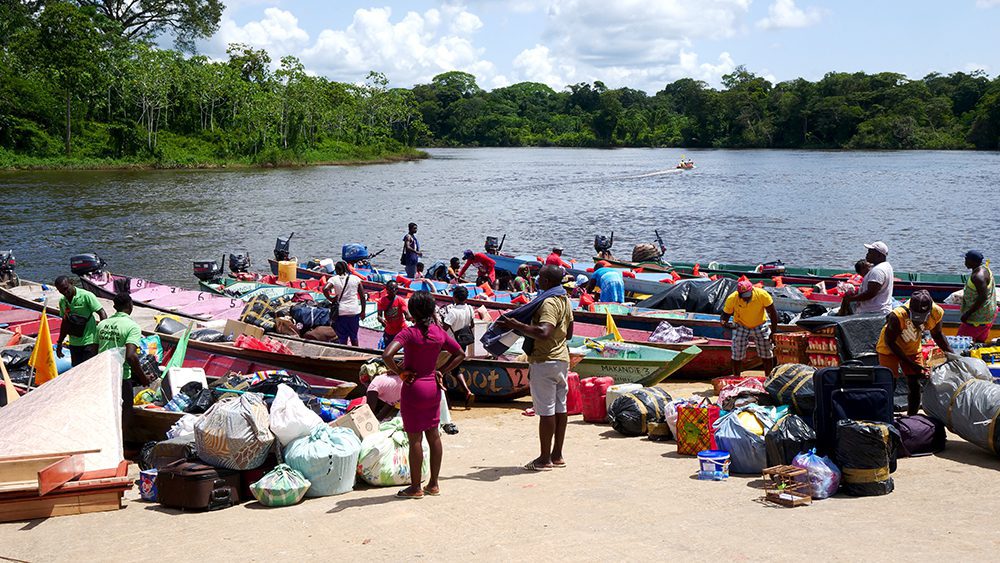
Atjoni is a small but important town in this part of Suriname. At its port, you’ll find lots of boats that transport passengers to the various villages and islands along the Upper Suriname River. There, you can hire a boat captain to take you further down the Suriname River to Isadou Island immediately, or you can make a pit stop to get something to eat. The restaurant by the port is the perfect spot to refuel and fill your belly!

This guide to traveling around Suriname recommends the barbecued chicken and noodles. They come with French fries with mayonnaise on the side. The chicken is fresh, with a tasty, Indonesian-inspired marinade whose flavors seep into the meat. The combination of the marinade and the slightly charred barbecue taste are perfection!

From there, head over to the Fu Lin supermarket in town. There, you can buy any foods, drinks, or supplies you may want or need on Isadou Island. There is no beer on the island, so this is the place to buy some before you make the journey. Be sure to buy some for your boat captain as well!
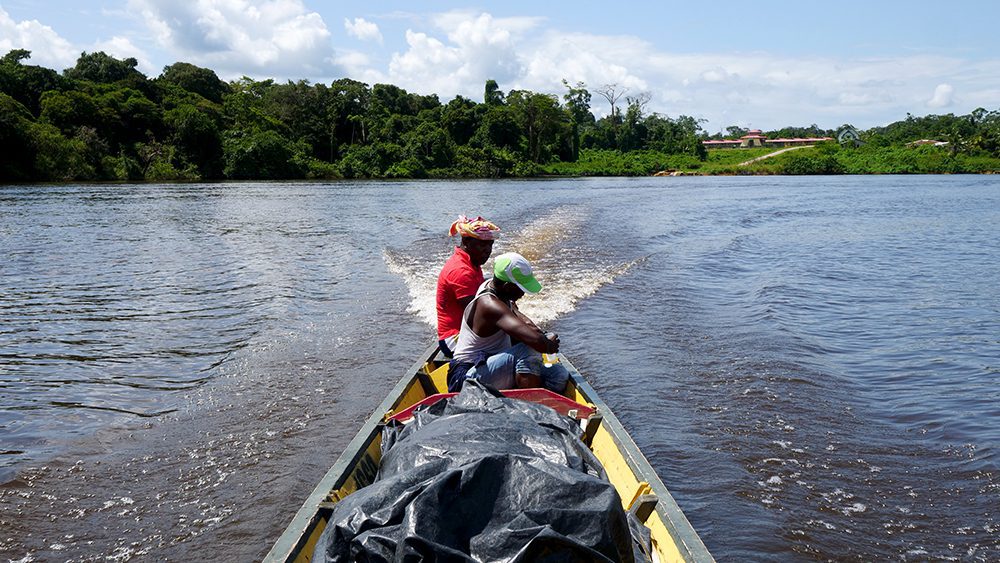
Like the trip from Albina to Galibi, you’ll make the journey from Atjoni to Isadou Island in a motorized canoe. Be sure to wear a life jacket just in case. As you’ll be out on the open water with no protection from the glaring sun, I suggest covering your arms, neck, legs, and face as best as possible. Regardless of your skin tone, the sun in this part of the world is brutal and can burn you.
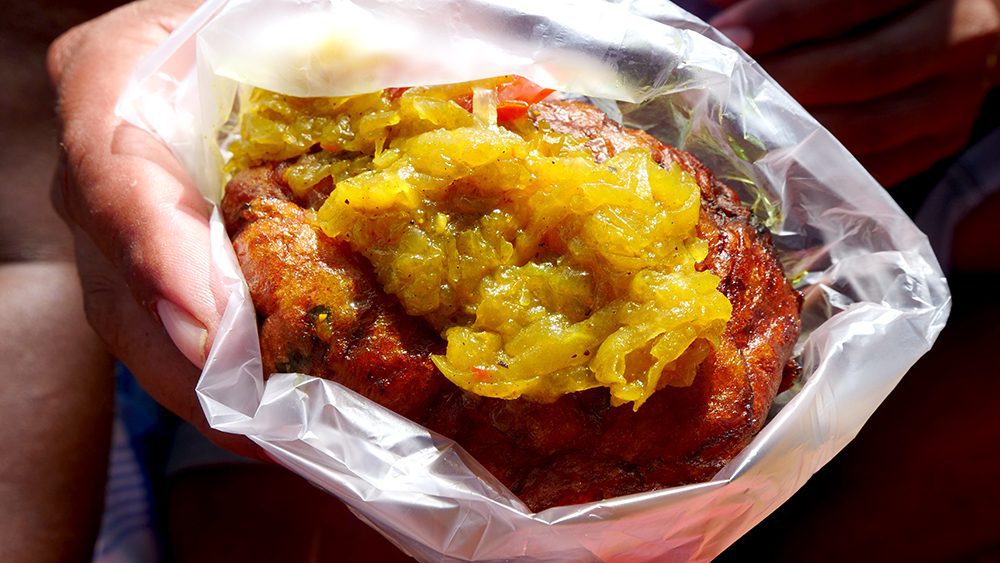
During my boat ride, I met a very nice woman whose destination was one of the villages along the river. She offered me some of her food: Indian vada with an African twist with some spicy mango chutney. It was the perfect thing to snack on!
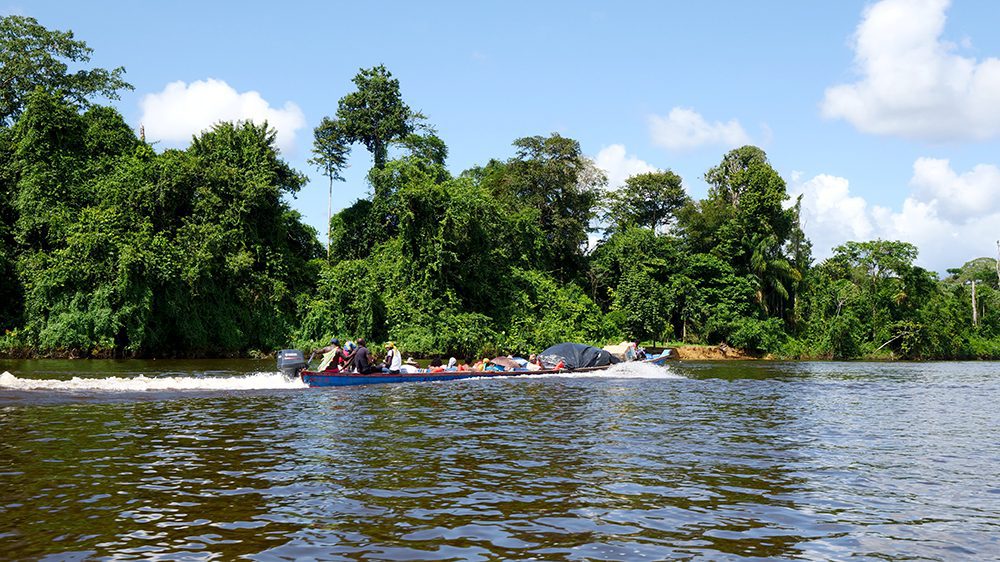
The ride to Isadou Island takes only 45 minutes. Keep your eyes peeled on the jungle surrounding you along the way. There are anaconda, monkeys, caiman, sloths, and toucans living in the area, and you might get a glimpse of one during your trip. As you get closer to the island, you’ll pass through an area of the river where the current is noticeably stronger and rougher. Soon afterward, you’ll get your first look at the bungalows of Isadou Island!
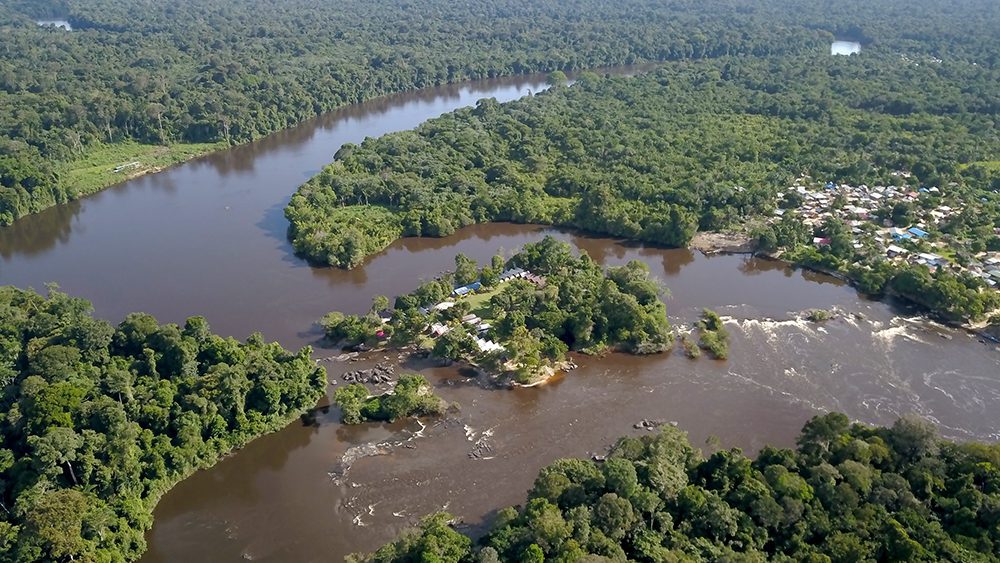
Isadou Island is the deepest we’ve traveled into Suriname so far. It’s so deep within the country’s interior that there is no WiFi there. Once you make it there, you’re about as disconnected from modern technology as you can get. It’s a blessing in disguise though, as you’ll have no need to try to send work emails, scroll through Instagram, or check your text messages. They won’t work on this pristine, unspoiled area in the Surinamese jungle. Instead, you’ll find yourself more connected to nature and to any people you come across, which is the real gift of Isadou Island.
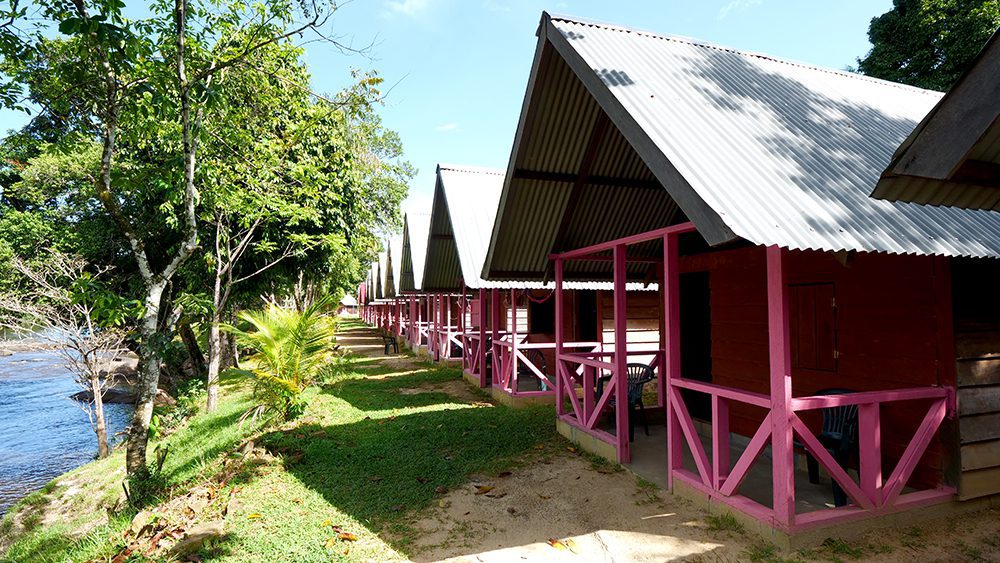
The Isadou Resort is made up of 28 cozy and minimalistic bungalows, many of which look out at the rushing river surrounding the island. The bathroom is right inside the entrance, and the main room contains two beds with mosquito netting over them. During your stay, you’ll likely eat most of your meals in the outdoor dining hall. The meals will be prepared by local Maroon tribespeople who live in the nearby Jaw Jaw village—more on that later.

In this guide to traveling around Suriname, I recommend taking some time to explore the trails of the surrounding jungle. The sun is brutal and the mosquitoes are relentless, so make sure to apply sunblock and mosquito repellent several times per day to protect yourself, regardless of whether you go on a jungle trek. Hopefully you’ll come across some of the native sloths, monkeys, and tropical birds, but know that wildlife sightings can be hit-or-miss. You might fare better hunting for caimans at night, as they become quite active after sundown.
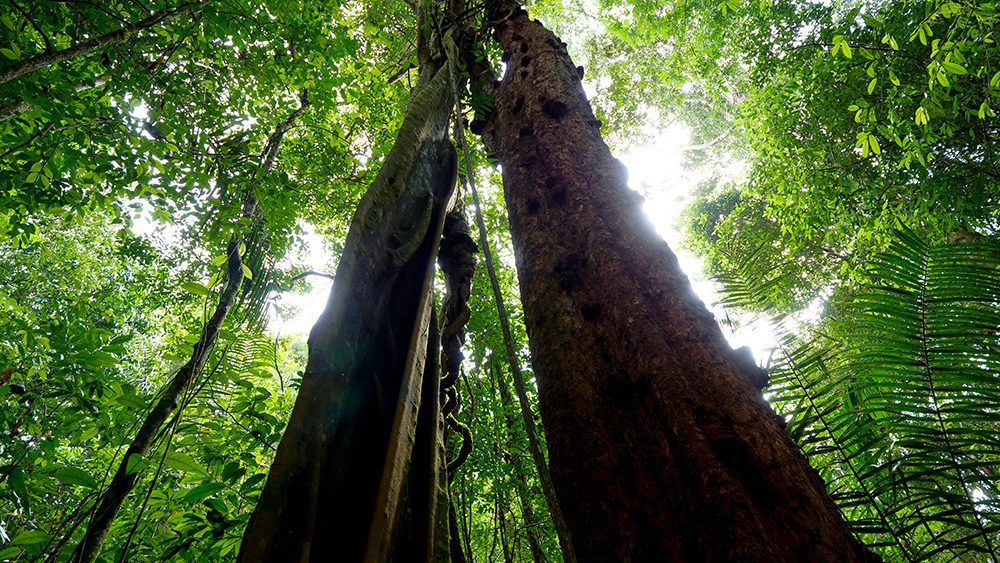
Another thing you must experience near the resort are the sols in the Suriname River. These are areas where the waters rush between rocks, creating a funnel effect in water that’s shallow enough for you to sit comfortably. Anchor your legs between these rocks and allow the water to pummel your neck and back. It’s almost like a natural massage and is a great way to beat the heat!
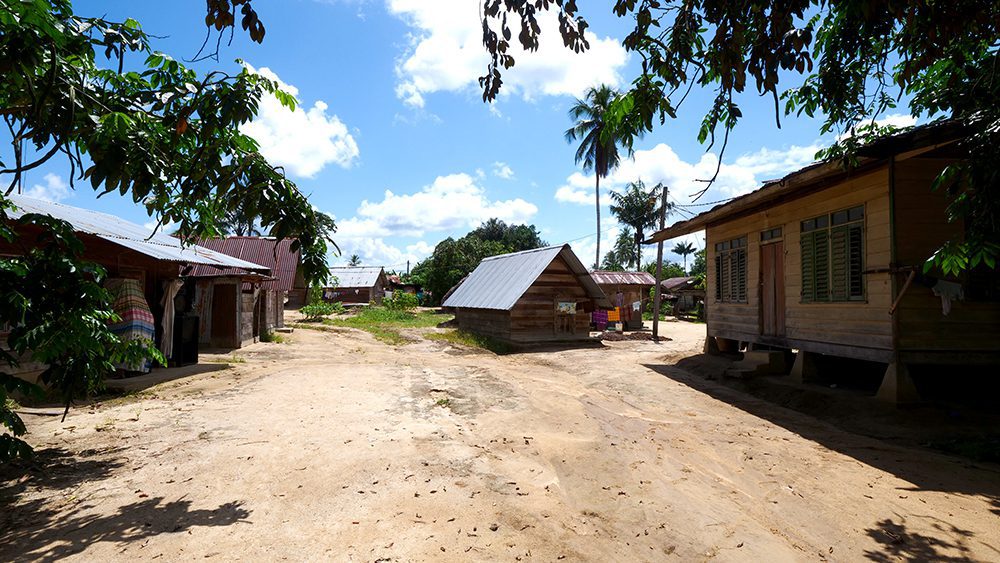
No trip to Isadou Island is complete without visiting Jaw Jaw village across the river. Like Brownsweg, Jaw Jaw is inhabited by the descendants of African slaves who escaped into the jungles of Suriname. These people, known as the Maroons, created many settlements throughout the country, including this village of roughly 500.
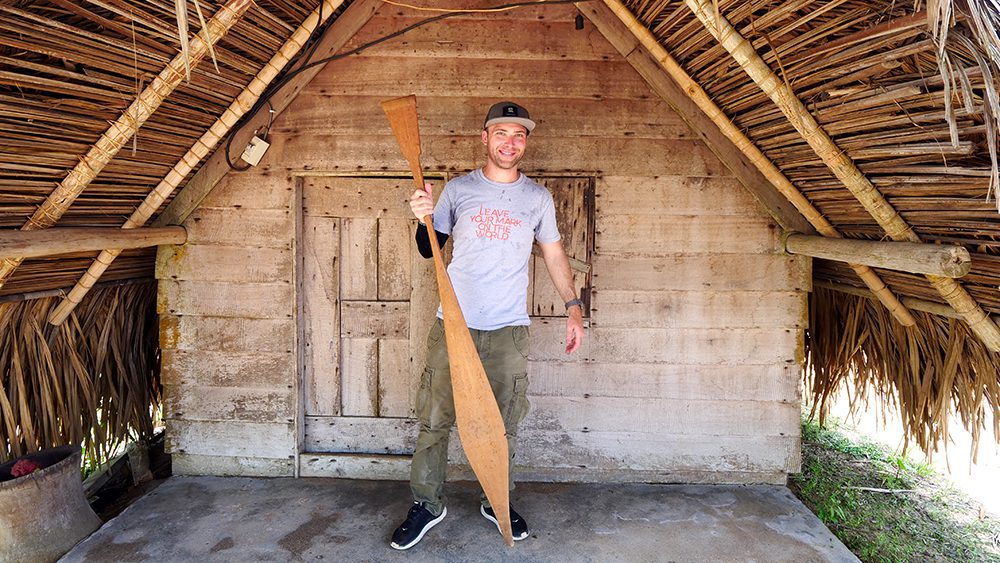
Touring this village and meeting the locals is a must. I found them to be quite friendly and eager to share their culture with me. I learned that married men and women live in separate houses and that their houses have electricity. They also burn wood and stretch it to make canoes to travel up and down the river. I got to watch a woman prepare casaba soup, and bought a colorful handmade scarf from another for 75 SRD, or about $10 USD.
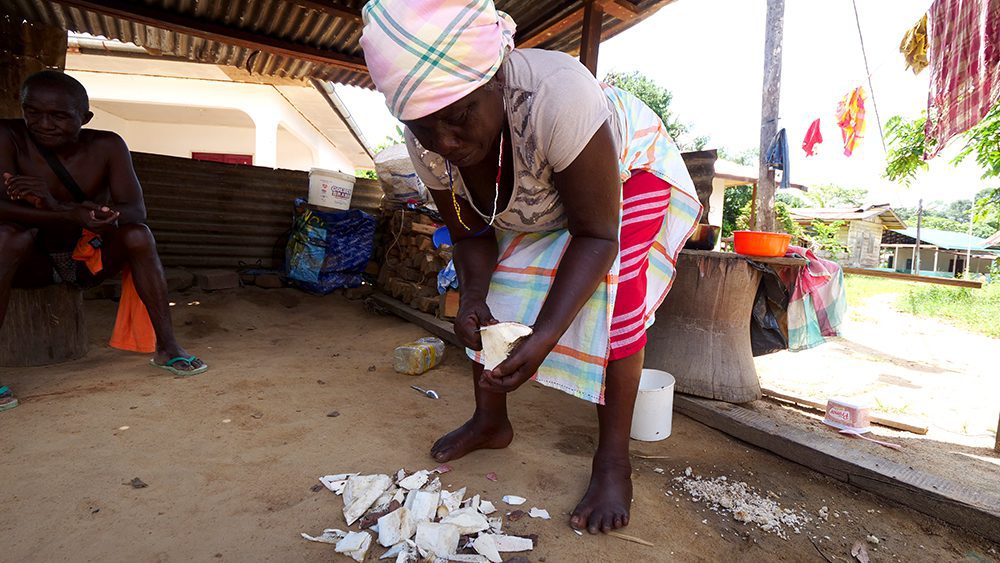
When I travel, I like to bring unique, handmade souvenirs home with me, like masks and other handicrafts I can display on my wall at home. I hadn’t had much luck finding anything in Suriname until then, when I came across a man with a six-foot-long, beautifully carved paddle. He sold it to me for 200 SRD, or about $25 USD. Always support local craftsmen and artisans when you travel. It’s a great way to support them and the local economy.
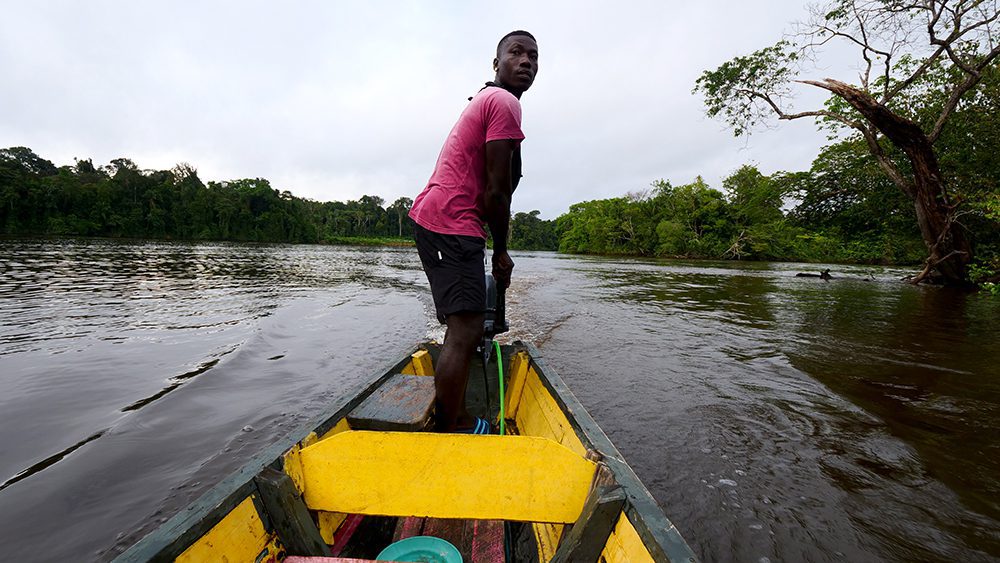
After your time on Isadou Island (I recommend 24-36 hours there), reverse direction and head back up to Atjoni. While you’re there, grab a quick snack like vada with mango chutney from the street food vendors there. You can never go wrong with mango chutney!
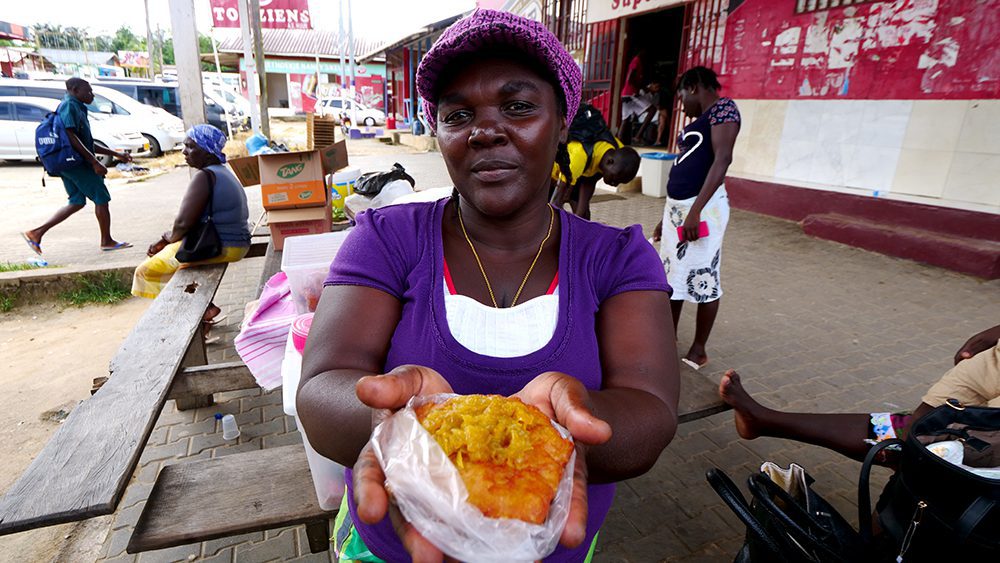
From there, we’re going to make our way back toward Paramaribo. However, we have another stop to make in a spot we should be pretty familiar with by now. Take the road from Atjoni and Pokigron back up to Brownsweg. There’s one thing we didn’t do in the area that deserves at least a full day of exploration: exploring Browns-Mountain in Brownsberg Nature Park.

The problem is, getting there can be tricky. The roads heading up the mountain from Brownsweg are notoriously bad. They’re unpaved and full of potholes, so they become sludgy, muddy messes. We took a bus up the road, and our driver handled the treacherous roads like a champ, but a 4×4 would also probably get the job done. Attempting to get up the mountain in anything lesser than that is a recipe for disaster, as the drivers of the stuck and stalled cars we passed can attest.
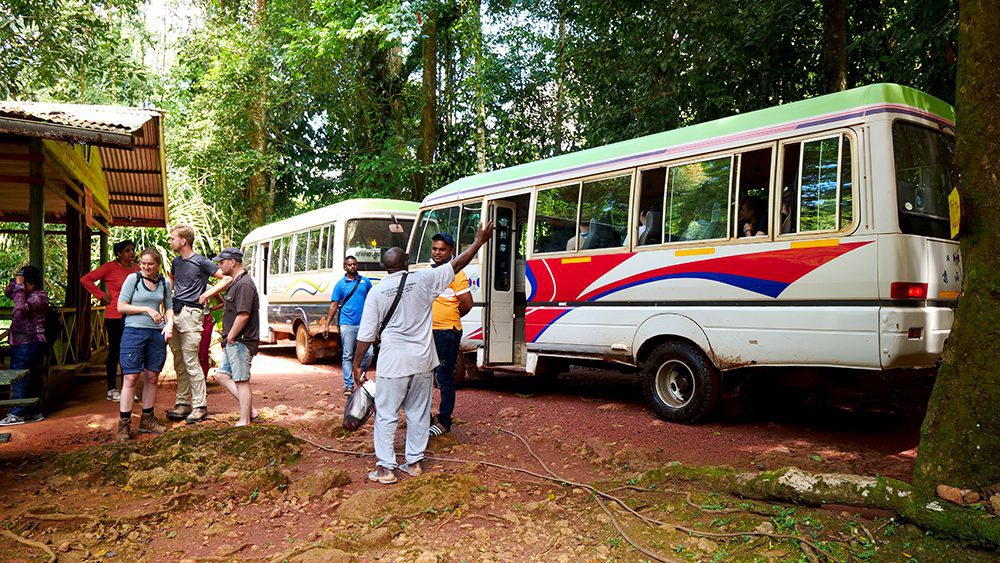
After a slow and deliberate climb up what are easily the worst roads I’ve ever been on, you’ll arrive at a campsite atop Browns-Mountain.

Besides the Brokopondo Reservoir, the main attraction in the Brownsweg area is Browns-Mountain. Browns-Mountain is a 500-meter-tall, jungle-covered mountain in the middle of the Brownsberg Nature Reserve. This gorgeous area along the western shore of the reservoir is a prime location for spotting wildlife like howler monkeys, toucans, parrots, armadillos, and even jaguars.

In addition to a wide variety of wildlife, Browns-Mountain is known for its unmatched beauty. From atop the mountain, you can enjoy incredible vistas of the surrounding jungle and the reservoir in the distance. You can also see more of what the mountain has to offer by following the trails from the campsite to the nearby waterfalls.
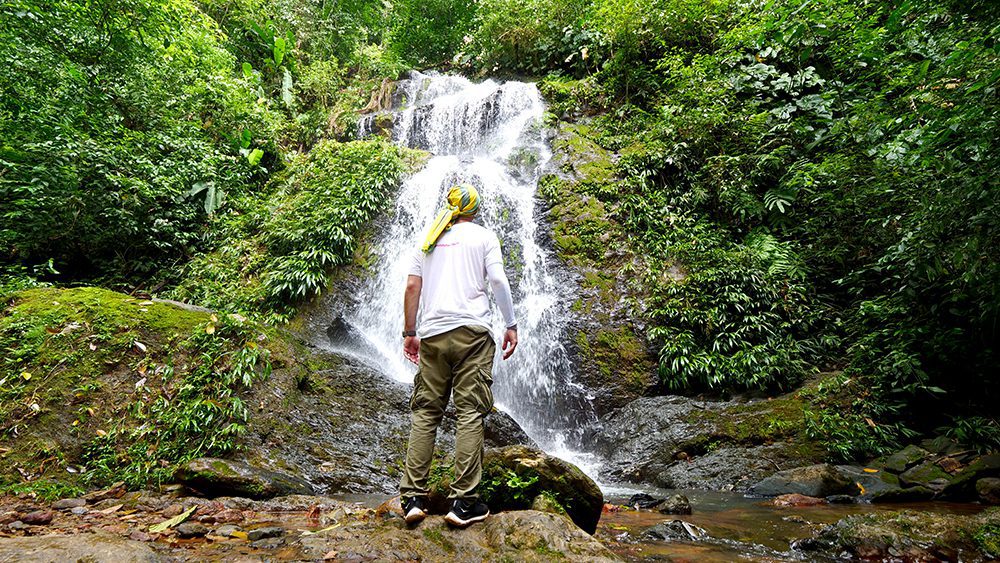
The treks to both waterfalls are steep and treacherous in spots, so wear proper hiking attire. There are ropes strung between the trees in the most challenging sections, so if you’re moderately fit, you should be able to manage both hikes with little problem. I managed the trek in sneakers, but this guide to traveling around Suriname recommends wearing hiking boots to be safe. Just go slowly, especially if the rocks are slick from recent rain. The strenuous journeys are worth it, though, as both waterfalls are spectacular and offer opportunities to cool off from the oppressive heat!
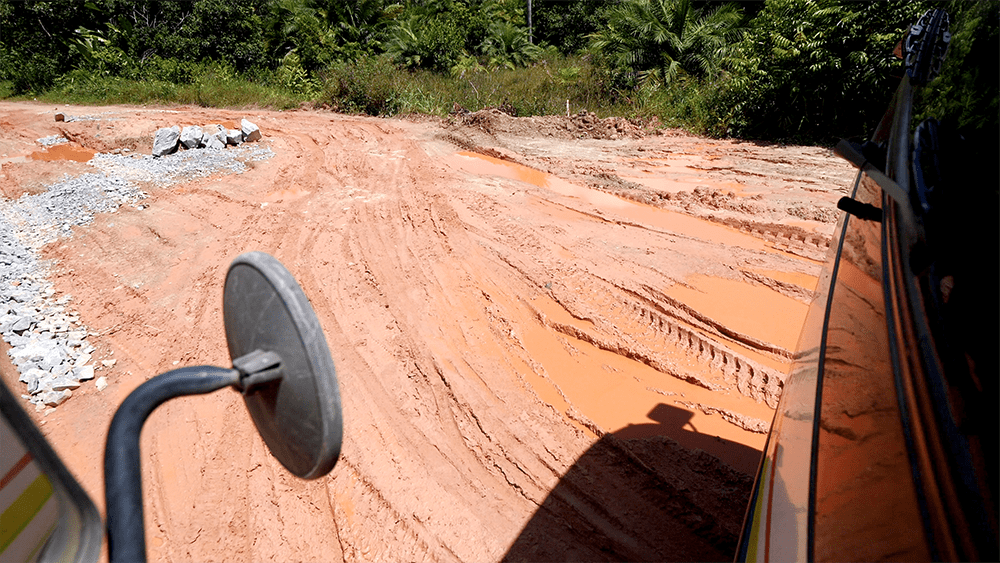
If you’re only going to Browns-Mountain and the Brownsberg Nature Park for the views and waterfalls, you should probably be able to fit everything you want to do in less than a day. I arrived there around lunchtime and spent much of the afternoon hiking to the waterfalls and left that same evening.
To continue the journey to Paramaribo, you’ll have to take the same awful road as before. If you’re driving yourself, take it slow and steady and always be on the lookout for mud pits and potholes. But if someone else is doing the driving, make sure they’re familiar with this road so you don’t get stuck!
It took us over an hour of careful driving to reach the paved road at the base of the mountain. By this point in my trip, I had run out of mosquito repellant (I highly recommend OFF! Deep Woods), so I bought a local brand on the way back to Paramaribo. The local brands don’t work nearly as well and I still had several days left in the country. Take this as a lesson learned. This guide to traveling around Suriname suggests bringing several bottles of OFF! Deep Woods with you. Buy more than you think you’ll need, as the mosquitoes are relentless and can easily sour any outdoor excursion.

I had wanted to stay at the Downtown Oasis Guesthouse for my one night in Paramaribo before heading off to Palumeu to next morning. However, they were all booked up, so I stayed at the Guesthouse Kiwi instead. As I mentioned earlier, the accommodations are pretty basic, but it would do for one night!
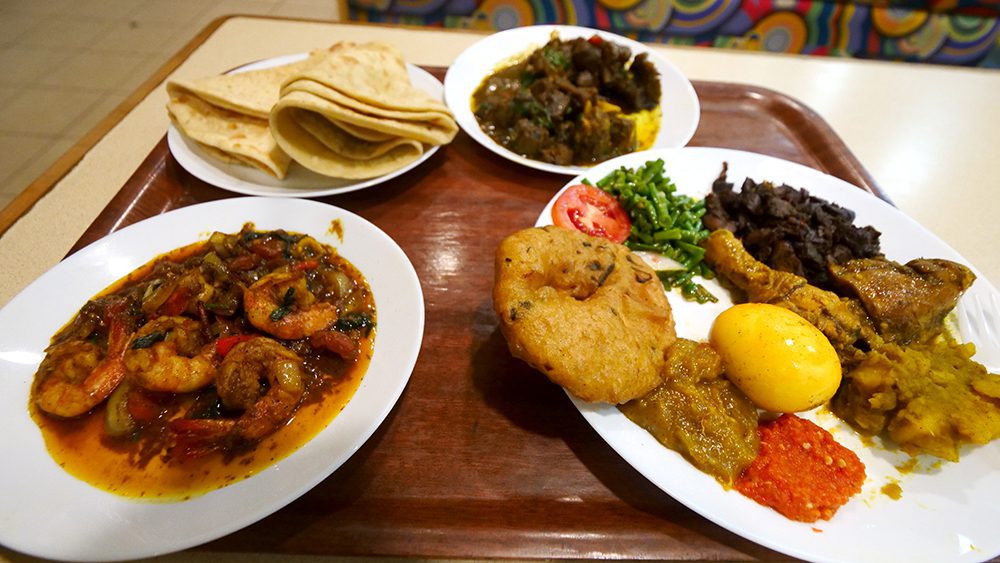
With roughly 12 hours in Paramaribo until the next leg of my adventure, my Jenny Tours guide Imro and I set out to find some food. My taste buds were set on Indian food, so he took me to a local spot called Roopram Restaurant. There, we enjoyed an enormous Surinamese Indian food spread that included vada, two different rotis, shrimp curry, aloo, sheep, duck, chicken curry, an egg, liver, green beans, liver with kidneys, mango chutney, cayenne chutney, and tomato chutney.
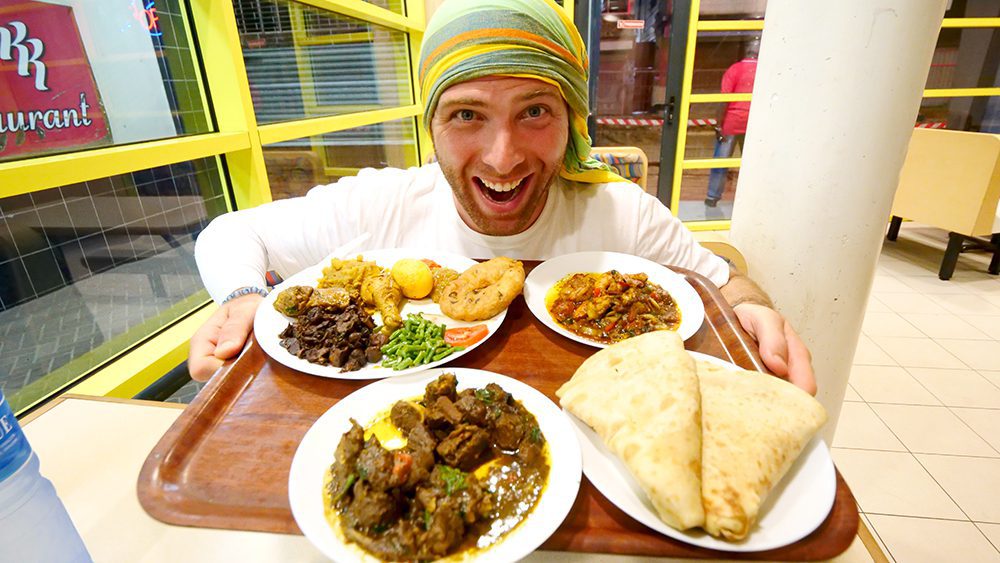
The bony duck, gamy sheep, iron-rich liver, and mix of sweet and spicy chutneys was heaven on my palate. The shrimp curry and chicken curry were both fresh as can be and bursting with flavor. I’m not usually a roti guy (I prefer naan and parathas in India) but these rotis were outstanding. All in all, this was my favorite meal in Suriname up to that point in my trip!
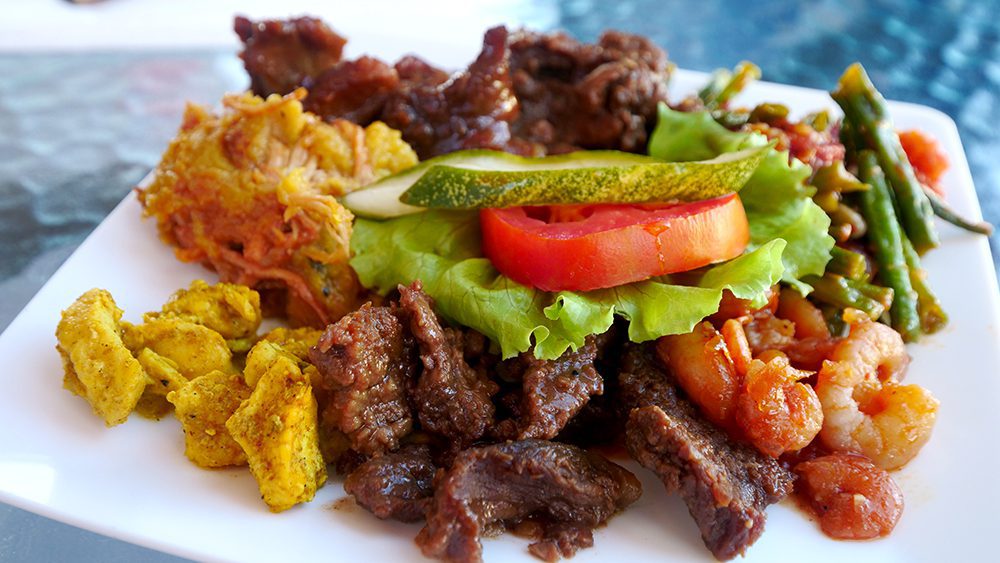
This guide to traveling around Suriname recommends grabbing some breakfast the next morning before beginning the next leg of your trip. I did just that at a local spot called Jennely’s Food House. They sell over 25 different breakfast options, so you have a lot to pick from. I went with chicken liver, cucumber, tomato, lettuce, beans, beef, pork, chicken pom, kidneys, and shrimp.

The food seemed to have Dutch, Indian, African, Chinese, and Indonesian influences. It’s served with a large bread bun, which is meant to be eaten with everything on your plate. Between the dense liver, oily shrimp, sweet chicken pom, and Chinese-inspired pork, I didn’t want this meal to end!
Unfortunately, after my meal, I had to say good-bye to my friend and guide Imro, who wouldn’t be joining me on my next adventure. He was a massive help to me and taught me so much about Suriname. I couldn’t have managed this trip without him!
But with more adventures in Suriname’s wild interior ahead of me, I packed my things into a taxi and headed off to Zorg en Hoop Airport in Paramaribo to begin my journey to Palumeu!

While there are other ways of reaching Palumeu, this guide to traveling around Suriname recommends flying via Zorg en Hoop Airport. You can also reach Palumeu by taking a 12-day boat ride from Albina if you have the time (and patience) for it. Go with the plane ride. Chartering a plane may be expensive, but you can’t beat a 75-minute flight.
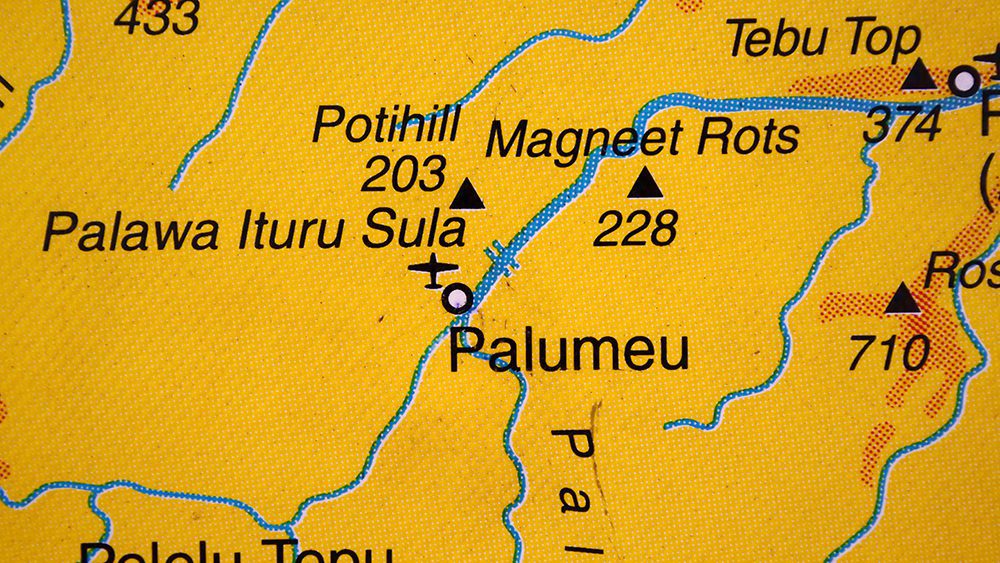
Because Palumeu is deep within the heavily-forested interior of Suriname, there’s nowhere for a large plane to land, so you’ll have to take a small charter plane. I hadn’t flown in one in years and I’ll admit, tiny planes make me nervous because you can feel every bit of turbulence in them.
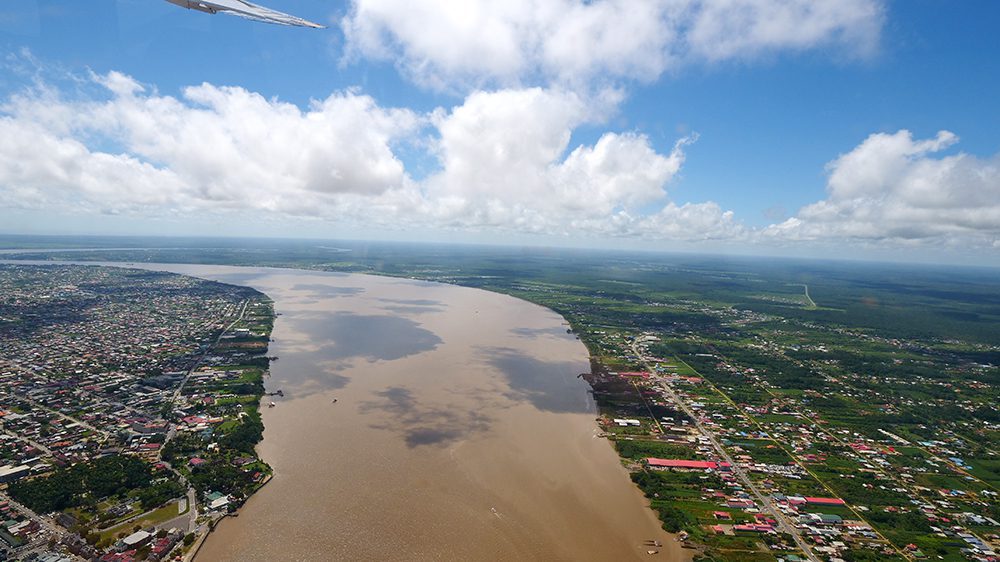
At the airport, I met my new guide, Julius from Mets Tours, who’d accompany me on my flight with Gum Air. You’ll also be weighed at the airport along with your luggage to make sure the plane won’t be overweight.

All in all, my journey to Palumeu was as smooth as I could have hoped for. The 10-seat plane was certainly small, but there was very little turbulence as we flew over miles and miles of jungle below us. We even flew over the Brokopondo Reservoir! Be prepared to make stops to pick up other passengers. We picked up some Dutch tourists at a tiny airfield after about 30 minutes and continued on for another 45 minutes until we arrived at the minuscule Vincent Fayks Airstrip in Palumeu.
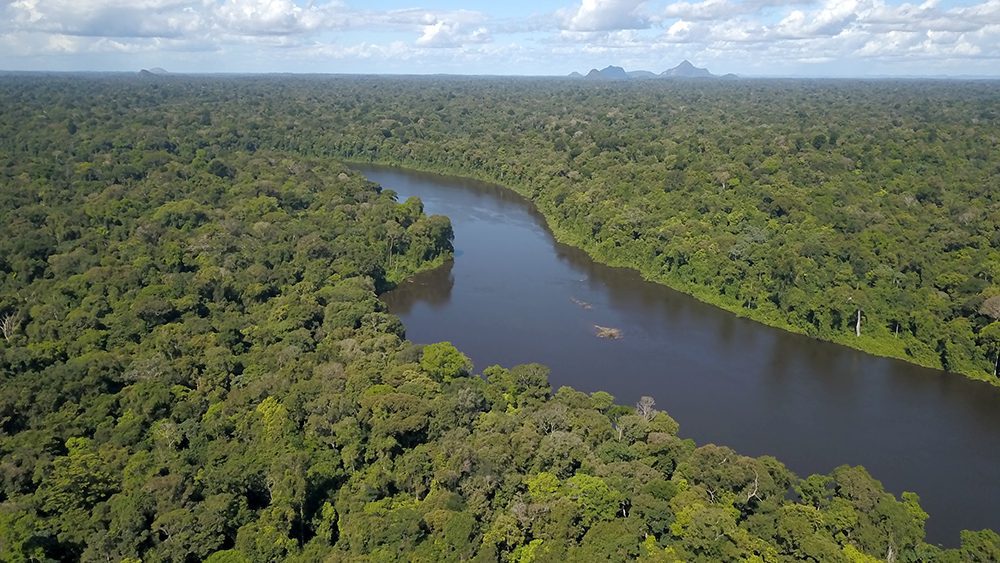
For a tiny village in the heart of the Surinamese rainforest, there’s actually a lot you can do in the area. Immediately upon arriving in Palumeu, I met Ose, who would serve as my second guide alongside Julius.
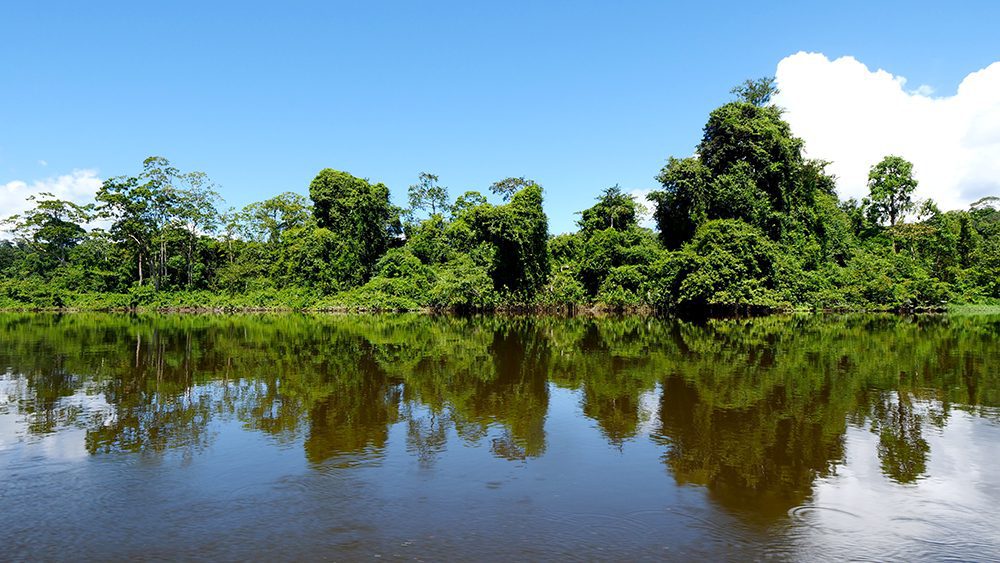
There are a few places you can stay in Palumeu, but I recommend the Palumeu Jungle Lodge. The accommodations are minimalistic and rustic, but they have electricity, which is perfect for any traveler who needs to charge their equipment.

We literally hit the ground running with my first activity, a ride down the Tapanahony River to lunch, followed by a trek through the nearby jungle to Poti Hill.

The lunch I had (fried fish, a tropical coleslaw, the ever-present peanut sauce, and mouthwatering yuca frita) was the perfect meal to fuel me as we continued deep into the jungle.
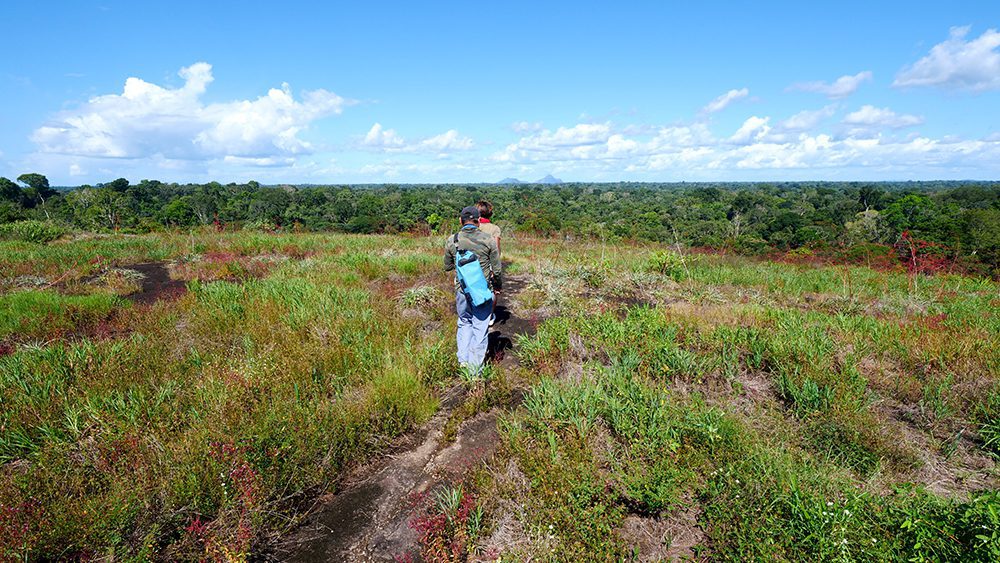
This guide to traveling around Suriname recommends wearing long sleeves and long pants when trekking through the jungle to Poti Hill. This will help protect you from the sun and mosquitoes, as well as the sharp and spiky plants that grow on the granite hill. You may also come across various animals during your hike, but outside of the strong smell of parrot feces and a loud bird overhead, I didn’t encounter much.
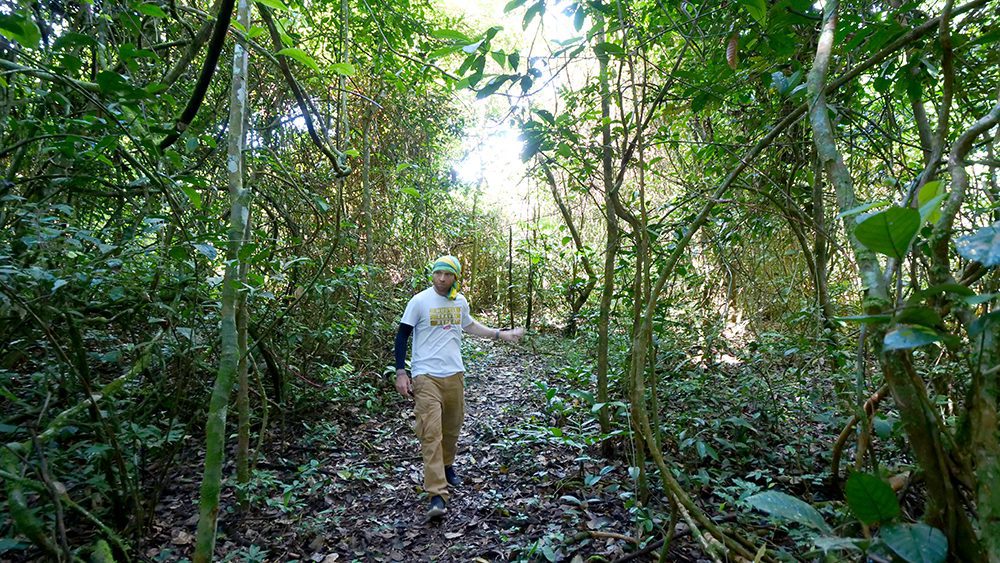
A second jungle trek will take you from the campground called Mabuka into the gorgeous primary and secondary forests in the area. The secondary forest is made up of dense, low brush, while the primary forest is home to immense trees that make you feel super small standing next to them. Animal life was scarce again, but we did come across a pair of camouflaged dry leaf frogs and a tarantula’s burrow.
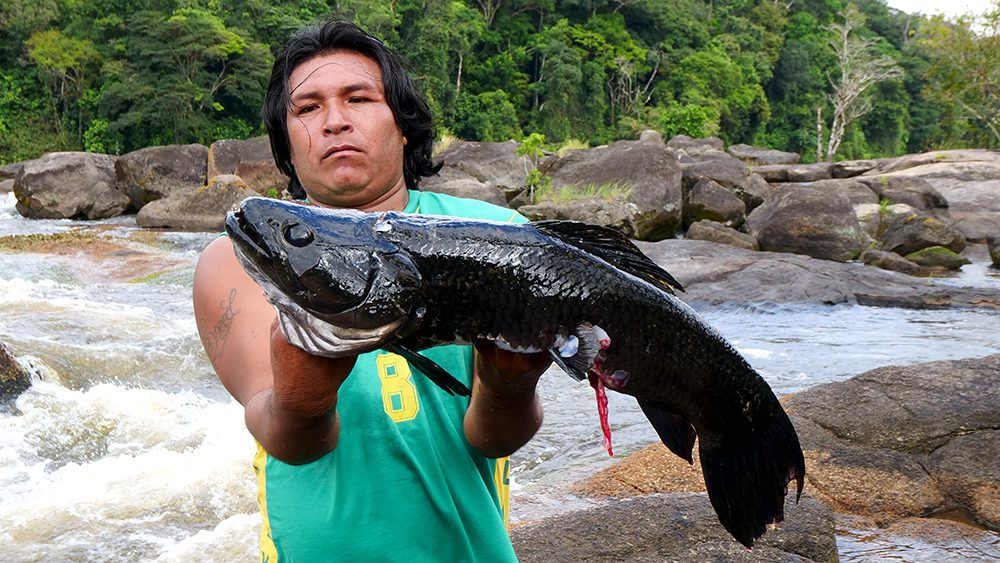
One activity you cannot miss in Palumeu is fishing. Fishing here is not the quiet, tranquil experience it is in most places around the world. Here, you have to take a boat ride through swirling, chaotic rapids until you reach a point where you can disembark and double back to the rapids on foot. Then, the locals fish by hopping across stepping stones in the middle of racing rapids and dropping their lures in the rushing waters!
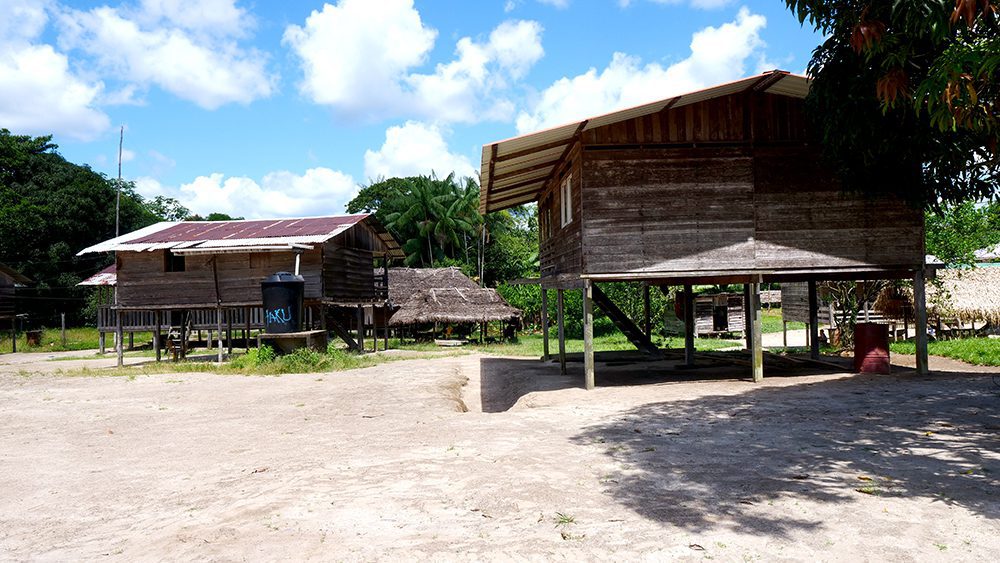
Of course, you can’t visit the Palumeu area without visiting the actual village. Palumeu is a tiny Amerindian settlement along the Tapanahony River. The dozen-or-so local homes are built on stilts to protect them from the river when it overflows its banks. Other structures in town include a wooden Baptist church and a large, open-air communal hall for banquets, meetings, and celebrations.

If you book through Mets Tours, your guides will show you around the village, where you’ll have the opportunity to try the local beer. In this guide to traveling around Suriname, I recommend trying it even if you’re not a big beer drinker. It’s a thick, cloudy, fermented drink that has a very earthy taste. It’s very refreshing and light on alcohol at only 3-5%, so drink up!
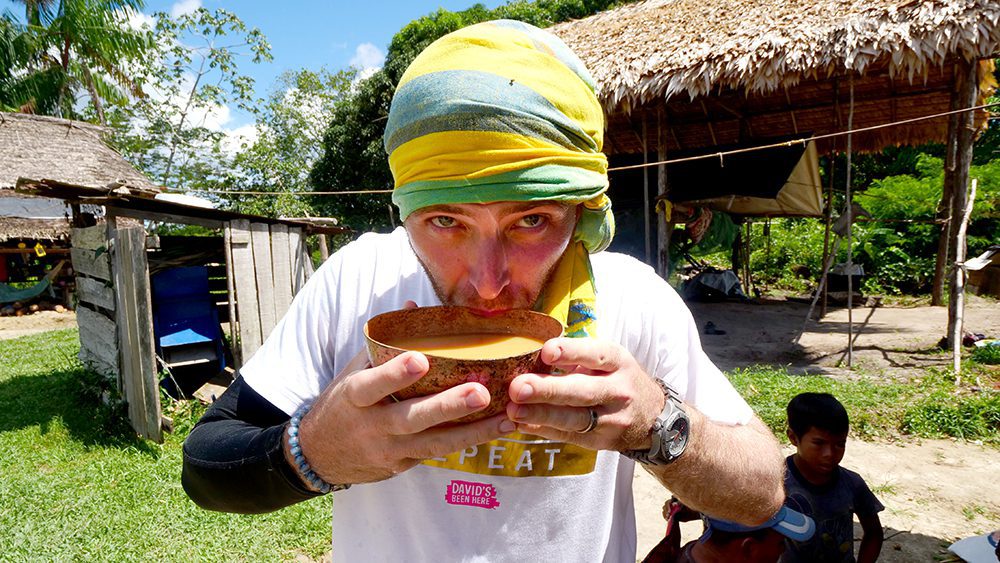
Don’t miss the opportunity to buy souvenirs from the local craftsmen as well. I was able to choose between a wooden flute, bracelets, maracas, necklaces, an arrow, and a knife. Locally-made, hand-crafted goods always make the best souvenirs, and these items, made mostly from wood, seeds, leaves, and other plant material, were perfect.
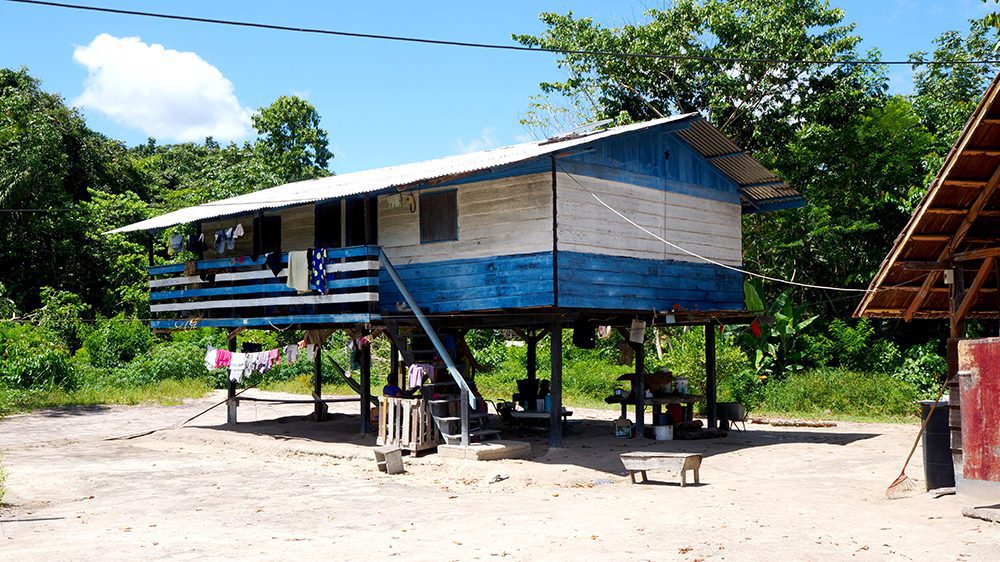
Palumeu was paradise to me. There are few things I enjoy more than being out in a jungle, on a river, and just being at one with nature. If you’re like me, then Palumeu is the perfect place for you to spend a couple of days. From there, just head back to Paramaribo the way you came!
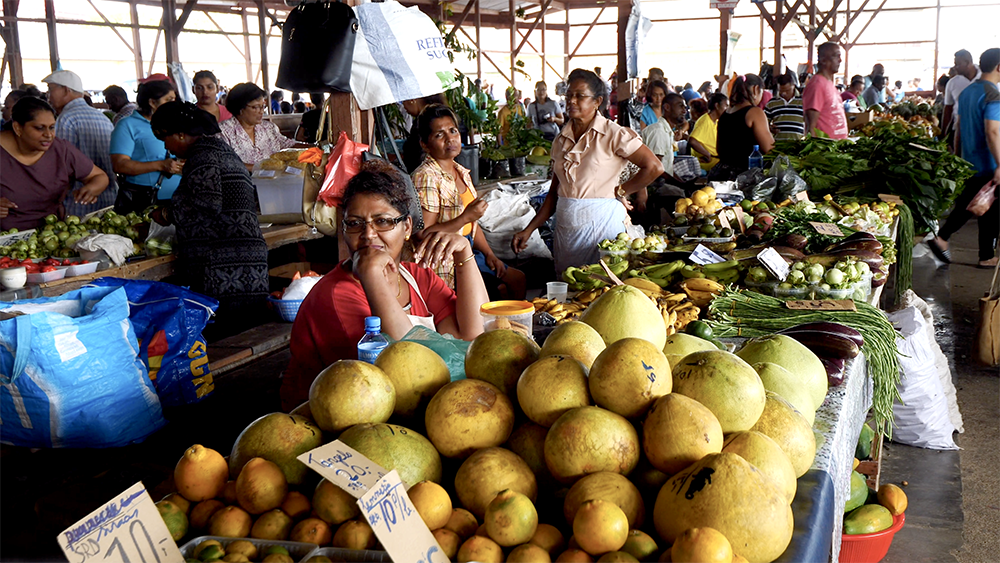
I won’t lie. After nearly a week and a half of staying in mostly rustic accommodations around Suriname, I wanted a change of pace before leaving. So, I checked into the Royal Torarica Hotel, the best luxury hotel in the country. Its 105 rooms are ultra-modern and a whole world away from the lodges in some of the country’s more remote regions. They offer high-speed internet and great hospitality, and have an incredible outdoor pool and even a botanical garden!

Once you’re back in Paramaribo, this guide to traveling around Suriname recommends linking back up with Jenny Tours so your last few days in the country go smoothly. I recommend hitting up Martin House of Indian Food for dinner.
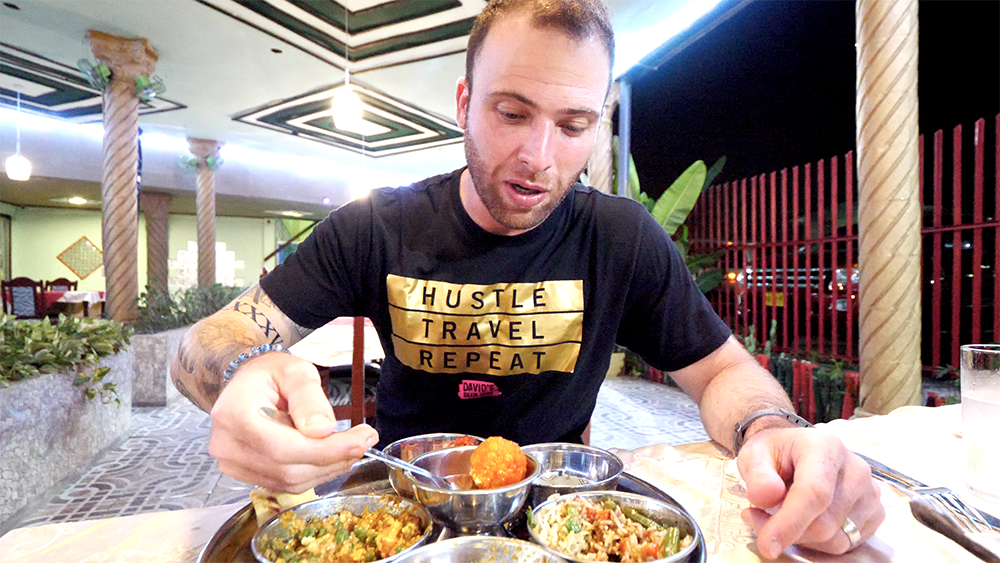
My friend and guide Jan took me there for a mind-blowing non-veg thali that contained fish curry, biryani, samosas, paneer, kachori, roti, chicken tandoori, and jamun. The fish curry and paneer were incredible, and the chicken tandoor was fresh and tender. Try it all with the tamarind and mango chutneys!

If you happen to be in Paramaribo on a Sunday, take some time to check out Kwatta Sunday Market. It’s an all-purpose market where you can buy meat, produce, clothing, and street food. If it’s street food you’re after, this guide to traveling around Suriname suggest the Chinese- and African-inspired barbecued chicken with brown beans and rice. It’s spicy and bursting with flavor! You also shouldn’t miss the Indonesian sweet-rice-and-coconut dessert ketan serundeng, the Jewish bojo cake, and the Indian vada and jalebi as well!
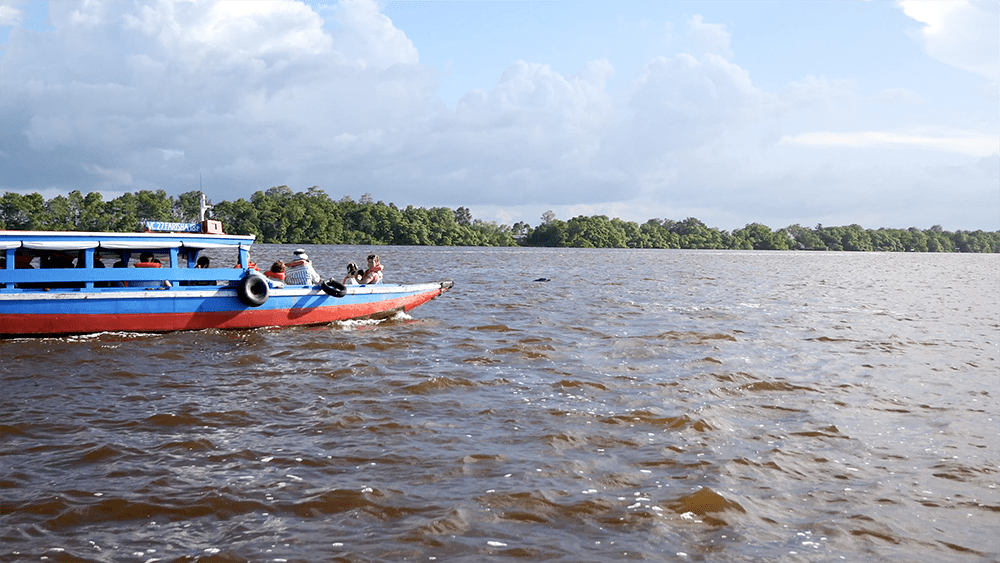
But the highlight of my time in Paramaribo, and a highlight of any trip to Suriname, will likely be the time you spend in the municipality of Johanna-Margaretha. Here, hire Jenny Tours to take you to the confluence of the Suriname and Commewijne Rivers, where you can see a beautiful and rare creature: the Guiana dolphin. These pink-hued dolphins like to splash around the water’s surface around sunset, so head out on your tour for this amazing, once-in-a-lifetime experience!
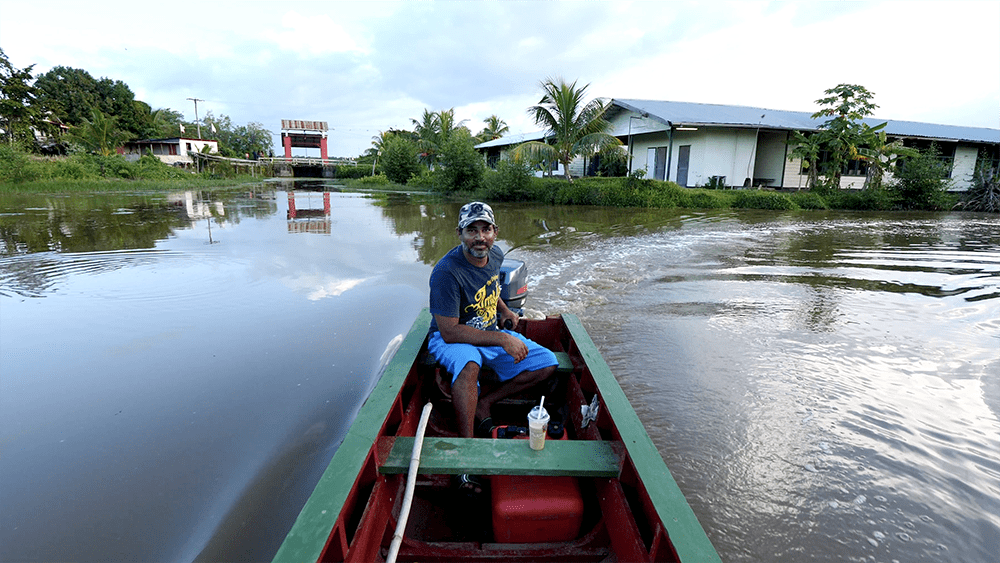
As your tour with Jenny Tours continues, you’ll ride down the canals off the Commewijne River and find yourself at the Johanna e Margaretha Plantation. The plantation, once known for its excessively cruel treatment of African slaves, is now owned by an Indian family. There, you’ll be invited to enjoy an Indian meal that includes fresh chicken curry, aloo, and greens. The masala on the chicken is out of this world!
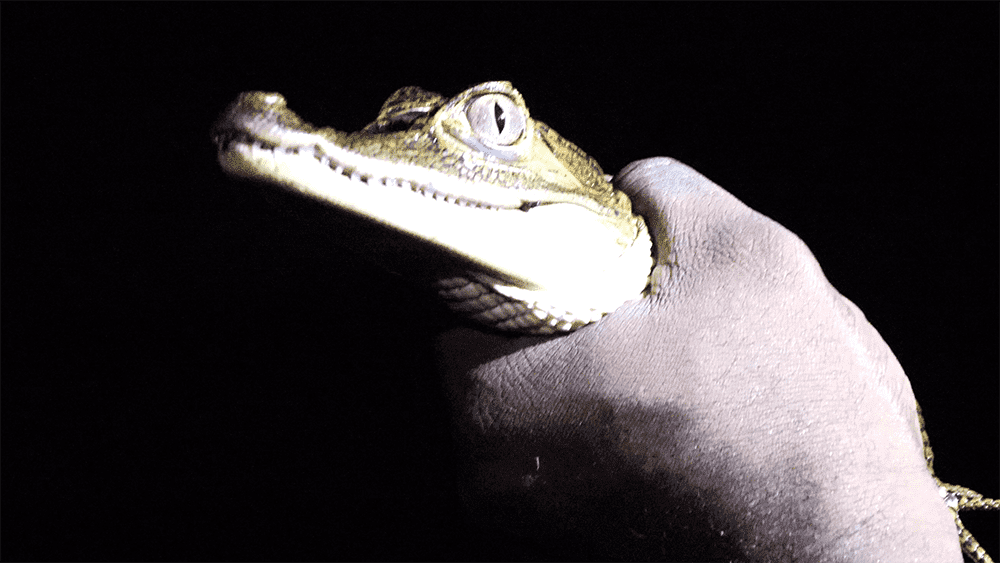
From there, this guide to traveling around Suriname recommends nighttime boat ride through the nearby mangrove swamps. The swamps, which are reminiscent of the Kerala backwaters, are home to caimans, and my guide Roël even caught a few of them! It’s the perfect way to end any trip to Suriname. Just remember your insect repellent—the mosquitoes out in the swamps are downright vicious!
I spent 11 days traveling around Suriname. During that time, I stayed in the southern and eastern parts of the country, but I unfortunately never got to explore the western part. Between Paramaribo and the national border with Guyana are three districts, Coronie, Nickerie, and Saramacca.
Coronie is the country’s least-populated district and is also home to Suriname’s largest freshwater swamp. The waters there are popular with anglers. Nickerie is located at the mouth of the Corentyne River and is known for its large Hindu population. Saramacca lies roughly between the Saramacca and Copename Rivers and is home to lots of family-run farms. The district is also a prime bird-watching location due to its populations of parrots, toucans, and rock roosters.

Touring Suriname will change your life. It’s such an under-the-radar location that deserves to be discovered by more travelers. The beauty of its beaches and interior are simply unmatched. But the most striking thing about Suriname is the tapestry of cultures that make up the modern-day nation. Every ethnic group that has settled within its borders has had a major impact on the culture, which can be seen as you walk its streets and explore its jungles. And, of course, it can be tasted when you eat its food. Each culture co-exists harmoniously and influences the others around it. It’s quite a beautiful thing to see! I hope my guide to traveling around Suriname has inspired you to see this gorgeous country. Book a trip to Paramaribo today to experience this life-altering country for yourself!
NOTE: If you need to check the visa requirements of a particular country, click here. To apply for a visa, find up-to-date visa information for different countries, and calculate the cost of a particular visa, click here!
Counter
101 Countries • 1432 Cities